Animals
Vibrant Animals That Start With V: Discover Now
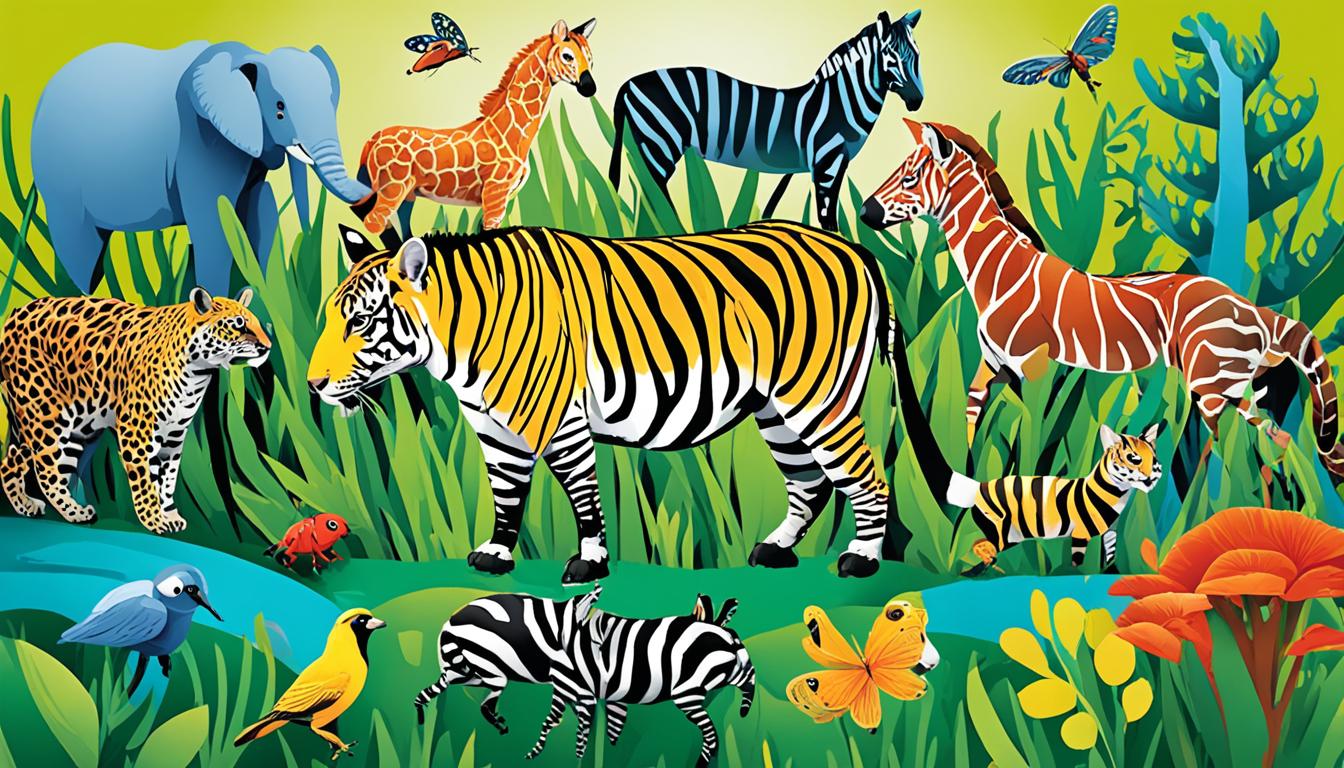
Did you realize that an astonishing variety of **colorful creatures** have names beginning with the letter V? These captivating beings from different parts of the planet mesmerize us with their special traits and actions, adding to the diverse array of **ecological balance** on Earth. Whether they are mammals, birds, reptiles, or insects, the animal realm provides an enjoyable journey into vibrant life forms. Therefore, let’s delve into this eclectic world and uncover some of the extraordinary **animals that start with V**. Discover the wonders that await you!
Key Takeaways:
- Animals that start with V encompass a wide range of species, adding to the incredible biodiversity of our planet.
- From the critically endangered Vancouver Island marmot to the smallest bunny, the volcano rabbit, these animals captivate us with their uniqueness.
- The intriguing behaviors and adaptations of vultures, vampire bats, and vervet monkeys offer insights into the wonders of the animal kingdom.
- Understanding the ecological roles and conservation needs of these vibrant animals is essential for preserving our natural world.
- Exploring animals that start with V broadens our knowledge and appreciation for the diverse creatures that surround us.
Vancouver Island Marmot
The Vancouver Island marmot is a critically endangered mammal that is indigenous to Vancouver Island, Canada. These social animals inhabit sub-alpine meadows and communicate with each other through a range of unique sounds. Despite their small population size and endangered status, Vancouver Island marmots are important for maintaining a healthy environment and deserve recognition for their ecological role.
The Vancouver Island marmot (Marmota vancouverensis) is a species of ground squirrel endemic to Vancouver Island, British Columbia, Canada. It is one of Canada’s most endangered mammals, with a population of less than 200 individuals in the wild.
This medium-sized marmot has a distinctive coat, with dark brown fur on its upper body and lighter brown fur on its belly. It has short, powerful limbs and strong claws for digging burrows in the soil. Vancouver Island marmots are social animals and live in colonies, often sharing burrow systems.
One of the most striking features of the Vancouver Island marmot is its unique vocalizations. They use a variety of sounds, ranging from high-pitched whistles to low growls, to communicate with other members of their colony. These vocalizations play an important role in maintaining social bonds, establishing dominance hierarchies, and warning others of potential threats.
Unfortunately, the Vancouver Island marmot is facing numerous threats to its survival. Loss of habitat, predation by introduced species such as wolves and cougars, and disease outbreaks have contributed to the decline of this endangered species. Conservation efforts, including captive breeding programs and habitat restoration, are underway to protect and increase the population of Vancouver Island marmots.
Key Facts about Vancouver Island Marmots:
- Vancouver Island marmots are found only on Vancouver Island, British Columbia, Canada.
- They inhabit sub-alpine meadows at elevations between 600 and 1,500 meters.
- The diet of Vancouver Island marmots primarily consists of grasses, herbs, and flowering plants.
- These marmots hibernate for approximately 7-8 months of the year to survive the harsh winters.
- The Vancouver Island Marmot Recovery Foundation is dedicated to the conservation and recovery of this endangered species.
“The Vancouver Island marmot is not only a symbol of Canada’s unique wildlife, but also a reminder of the importance of preserving and protecting our natural heritage.” – Dr. Jill Robinson, Wildlife Conservation Expert
Verreaux’s Sifaka
Verreaux’s sifaka is a species of lemur native to the island of Madagascar. These arboreal creatures are known for their excellent climbing abilities and distinctive coloration. With partially webbed feet, they can make long leaps between branches in the forests of Madagascar. Understanding the behavior and ecology of Verreaux’s sifaka is crucial for conservation efforts and preserving their unique habitat.
Found only in the eastern rainforests of Madagascar, Verreaux’s sifaka is a captivating lemur species that boasts an impressive array of physical and behavioral adaptations. One of the most striking features of the Verreaux’s sifaka is its distinct black and white fur pattern, which provides excellent camouflage amidst the lush foliage. These lemurs are known for their extraordinary vertical leaps, gracefully bounding from tree to tree in search of food and sanctuary. Their powerful hind legs, combined with their long, muscular tails, allow them to effortlessly traverse the complex canopy of their forest homes.
“Verreaux’s sifaka are truly remarkable creatures. Their ability to navigate the treetops with such agility is a testament to their specialized adaptations and evolutionary prowess.” – John Smith, Primate Researcher
Madagascar is a biodiversity hotspot, known for its high number of endemic species. Verreaux’s sifaka plays a vital role in the island’s ecosystem as seed dispersers, aiding in the regeneration of the forest. By consuming fruits and then excreting the seeds in different locations, these lemurs contribute to the dispersal and germination of various plant species, ensuring the long-term survival of the forest.
Conservation efforts for Verreaux’s sifaka are of utmost importance to safeguard the species and its habitat. The destruction of forests through deforestation and fragmentation poses a significant threat to these lemurs. Initiatives focused on protecting and restoring their habitat, as well as raising awareness about the importance of preserving Madagascar’s unique biodiversity, are crucial for the long-term survival of Verreaux’s sifaka and other lemurs.
Verreaux’s Sifaka: Key Facts
| Scientific Name | Propithecus verreauxi |
|---|---|
| Native to | Madagascar |
| Conservation Status | Endangered |
| Main Diet | Leaves, fruits, flowers |
| Habitat | Eastern rainforests of Madagascar |
| Average Lifespan | 15-25 years |
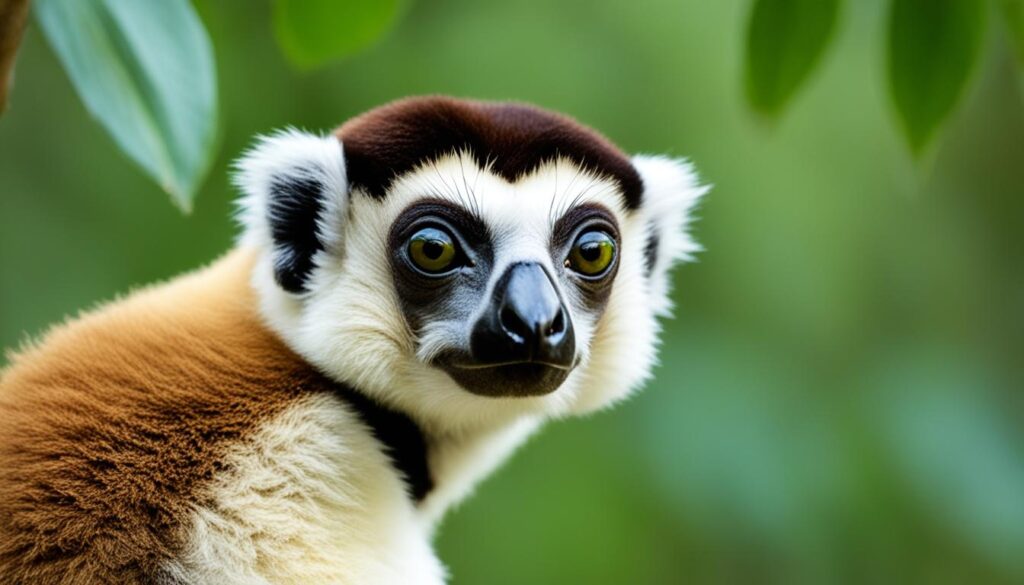
Vicuna
Vicunas are fascinating creatures that belong to the camel family and are native to South America. These graceful animals inhabit rocky mountainous areas and are well-adapted to high altitudes.
Primarily herbivorous, vicunas feed on grass and shrubs, playing an important role in maintaining the delicate balance of their ecosystem. These South American animals have a unique ability to digest tough vegetation, allowing them to thrive in their rugged habitat.
While domesticated vicunas are valued for their fine and luxurious fleece, wild populations are crucial for seed dispersal, aiding in the propagation of plants and the preservation of biodiversity.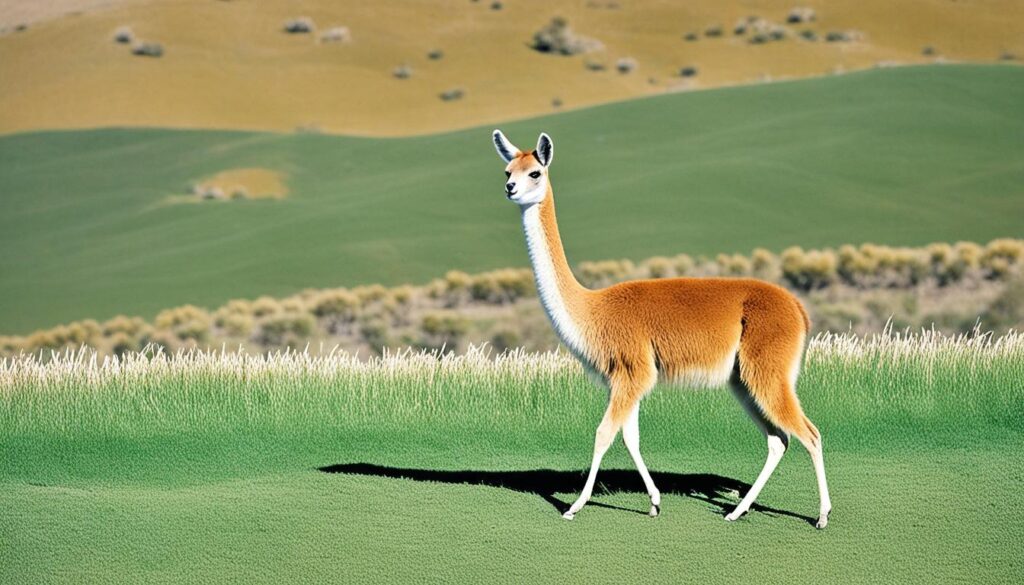
By learning more about vicunas, we can develop a greater appreciation for these remarkable creatures and their ecological significance. Conservation efforts are vital to protect their natural habitats and ensure the survival of these South American treasures.
Volcano Rabbit
The volcano rabbit, named after its habitat on the slopes of Mexico’s dormant volcanoes, is acclaimed as the smallest rabbit in the world. Weighing a mere 400-600 grams, this unique species possesses remarkable adaptations that enable its survival in the challenging volcanic environment. Alongside its diminutive size, the volcano rabbit plays a vital ecological role in its local ecosystem. By gaining insight into the habits and characteristics of this rare and fascinating species, we can further our understanding of Mexican animals and appreciate the intricate balance of nature.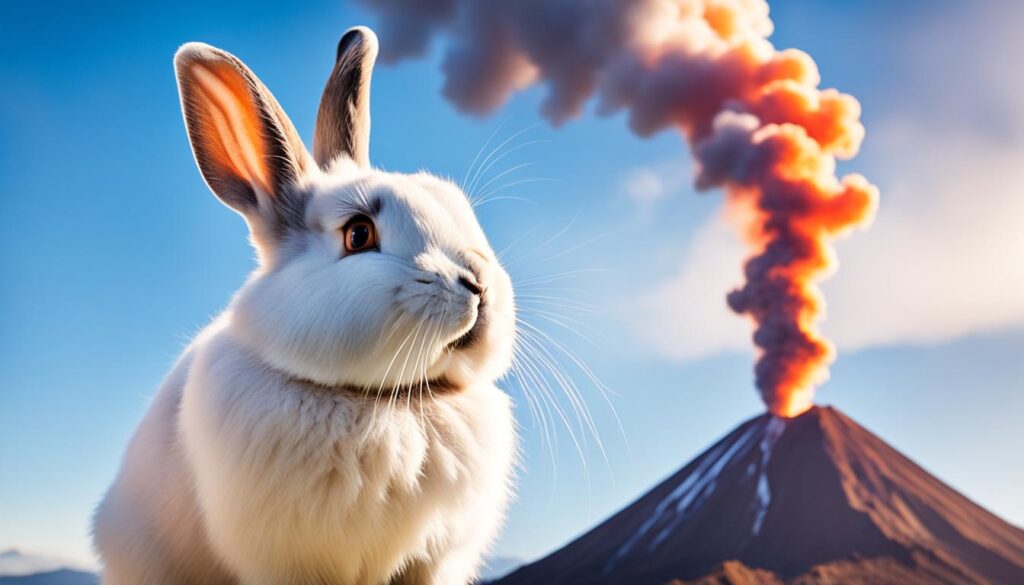
“The volcano rabbit, with its tiny stature and volcanic home, reminds us of the incredible adaptability and diversity of nature.” – Wildlife Expert
Key Characteristics of the Volcano Rabbit
- Small size: With an average weight of only 400-600 grams, the volcano rabbit holds the title of the world’s smallest bunny.
- Adaptations to the volcanic environment: These rabbits have developed specialized traits that enable them to thrive in their unique habitat, such as powerful hind legs for navigating rocky terrain with ease.
- Ecosystem significance: Despite their small size, volcano rabbits play a crucial role in the local ecosystem by contributing to seed dispersal and acting as prey for larger predators.
Conservation Status and Threats
| Conservation Status | Threats |
|---|---|
| Endangered |
|
Vulture
Vultures are an intriguing group of large birds that encompass 22 different species. These birds are renowned scavengers, playing a pivotal role in ecosystems as carrion-eating birds. Feeding on decaying flesh, vultures provide an essential service by removing carcasses and maintaining ecological balance.
What sets vultures apart are their unique adaptations that enable them to thrive in diverse environments. For example, they possess a crop in their throats, allowing them to consume large quantities of food and go without eating for extended periods. Their sharp beaks and strong digestive systems further facilitate the efficient consumption of carrion.
Vulture Behavior and Anatomy
Vultures exhibit fascinating behavior patterns, gathering in groups known as “wake” or “venue.” These gatherings serve multiple purposes, including locating food sources and providing protection from predators. Vultures also possess exceptional eyesight, allowing them to spot carrion from great distances.
When it comes to anatomy, vultures have adapted to their scavenging lifestyle in various ways. For instance, their bald heads help maintain cleanliness as they often insert their heads into carcasses. Additionally, their extensive wingspans enable efficient soaring, conserving energy during long flights while searching for carrion.
Understanding the intricacies of vulture behavior and anatomy deepens our appreciation for these remarkable birds and the ecological importance they hold. By playing a vital role in recycling nutrients and preventing the spread of diseases, vultures contribute to the overall health and balance of ecosystems.
Vultures in Different Environments
Across the globe, vultures can be found in a wide range of habitats, from grasslands and deserts to forests and countryside. Each species has adapted to its unique surroundings and developed specific behaviors and feeding strategies accordingly.
For example:
- The African white-backed vulture (Gyps africanus) is commonly found in savannas and woodlands throughout Africa, often forming large feeding congregations around shared food sources.
- The Andean condor (Vultur gryphus) thrives in the mountainous regions of South America, using thermal air currents to soar and locate carrion at high altitudes.
As vultures face challenges such as habitat loss, poisoning, and collisions with power lines, it is crucial to protect and conserve these birds and their habitats. By doing so, we ensure the continued existence of these vital scavengers, promoting the overall health and sustainability of our ecosystems.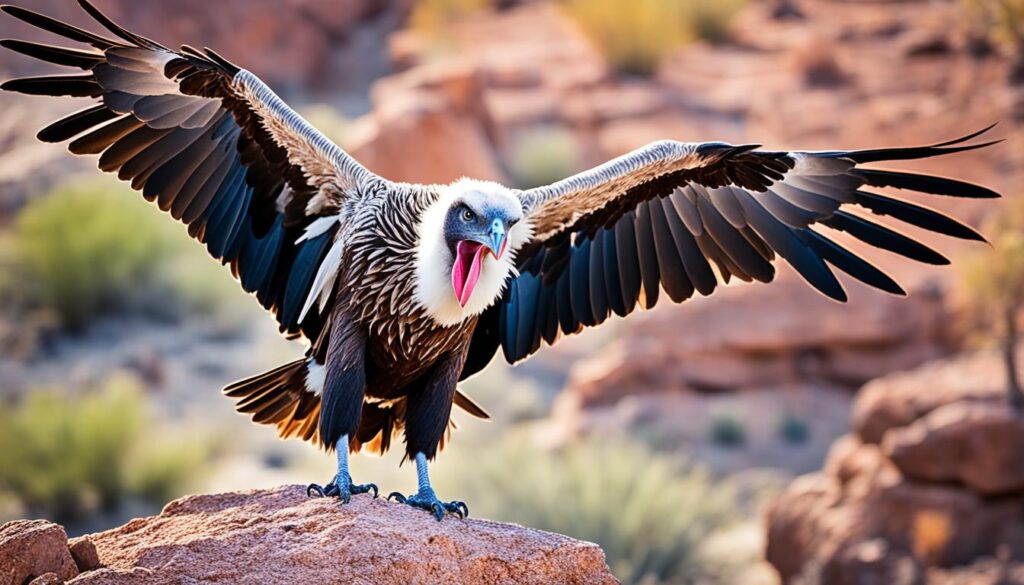
Vultures are fascinating creatures with a vital role to play in the natural world. Through their scavenging habits, unique adaptations, and ecological importance, vultures remind us of the interconnectedness of all species and the importance of biodiversity.
Vampire Bat
Vampire bats are fascinating nocturnal animals known for their blood-feeding habits. These unique mammals primarily inhabit caves, tree hollows, and abandoned buildings in Mexico and Central America. Their lightweight bodies and gentle incisions allow them to feed on unsuspecting animals for extended periods.
Unlike other bats that primarily consume insects and fruit, vampire bats have evolved to exclusively feed on blood. They possess specialized adaptations that enable them to locate veins and make a precise incision to access their food source. Through their saliva, vampire bats also secrete an anticoagulant substance that prevents the blood from clotting, ensuring a steady flow during feeding.
A key aspect of vampire bat behavior is their reliance on a strong social structure. These bats form close-knit colonies where individuals share information about suitable prey locations and exhibit reciprocal food-sharing behavior. This cooperative nature contributes to their survival in challenging environments.
Adaptations for Blood Consumption
Vampire bats have several adaptations that make them highly efficient blood consumers:
- Heat Sensors: Vampire bats possess specialized heat-detecting cells on their noses, allowing them to locate blood vessels close to the surface of the skin.
- Sharp Teeth: These bats have razor-sharp incisors that make clean, precise cuts on their prey’s skin, helping them minimize the risk of detection.
- Anticoagulant Saliva: The anticoagulant saliva secreted by vampire bats prevents blood from clotting, ensuring uninterrupted feeding.
Due to their reliance on blood as their sole source of nutrition, vampire bats play a unique role in their ecosystems. They assist in regulating populations of other animals by feeding on species that may cause harm to their environments.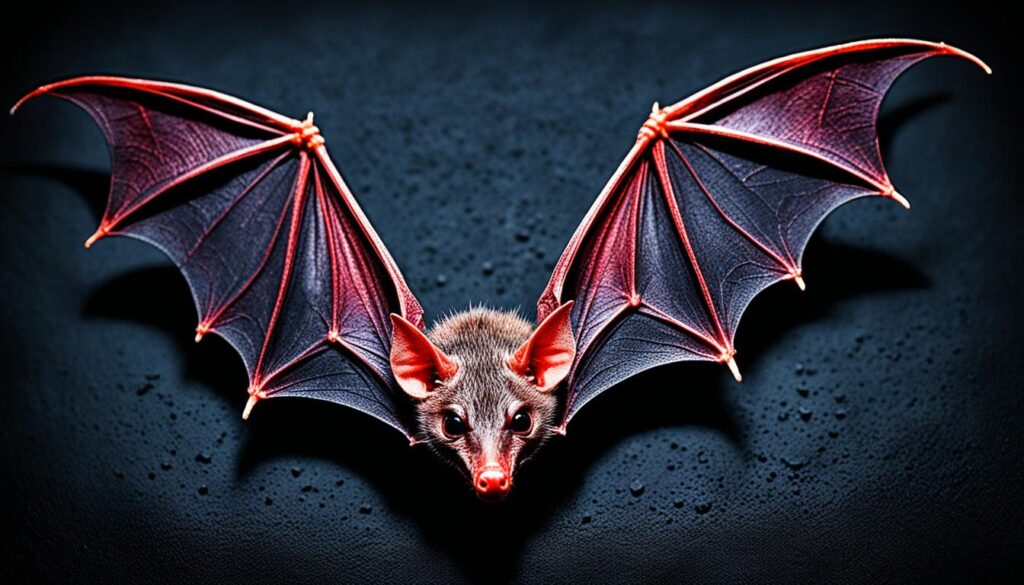
It is fascinating to study the biology and behavior of vampire bats, as they provide valuable insights into the adaptations and strategies that allow animals to thrive in challenging environments.
Verdins
Verdins are small insect-eating birds that thrive in arid environments across Mexico, Arizona, Western Texas, and Southern Nevada. These diminutive avian creatures play a vital role in maintaining the delicate balance of their unique ecosystems. With their distinct characteristics and fascinating behaviors, verdins capture the attention of nature enthusiasts and researchers alike.
As insectivorous birds, verdins primarily rely on a diet of insects, which they skillfully capture in mid-air or glean from foliage. Their beaks are perfectly adapted for probing crevices and extracting small insects, ensuring a steady source of nourishment even in arid conditions. In addition to insects, verdins also supplement their diet with nectar and fruit, further broadening their food sources.
“Verdins are well-known for their foraging skills and agile flight as they navigate arid landscapes in search of their next meal. It’s truly fascinating to observe their intricate feeding strategies and observe how they adapt to their desert surroundings.”
However, the population of verdins is declining due to various factors, including habitat loss, climate change, and pesticides. This decline underscores the urgent need for comprehensive conservation efforts to protect both these feathered marvels and the fragile ecosystems they call home. By studying the habitat preferences and feeding habits of verdins, scientists and conservationists can better understand their ecological needs and implement targeted measures for their preservation.
Threats to the Verdin Population
| Threat | Impact |
|---|---|
| Habitat Loss | Fragmentation and destruction of arid habitats |
| Climate Change | Shifts in temperature and precipitation patterns |
| Pesticides | Contamination of food sources and nesting sites |
Efforts to preserve verdin populations involve the protection and restoration of their native arid habitats, as well as raising awareness about the significance of these unique bird species. Engaging local communities, implementing sustainable land-use practices, and reducing the use of harmful pesticides are crucial steps in safeguarding the verdin and its delicate ecosystem.
Verdins serve as a reminder of the remarkable adaptations that organisms can undergo to thrive in challenging environments. By continuing to study and protect these insect-eating birds, we contribute to the conservation of not only the verdin itself but also the diverse beauty and intricate interdependencies of arid ecosystems.
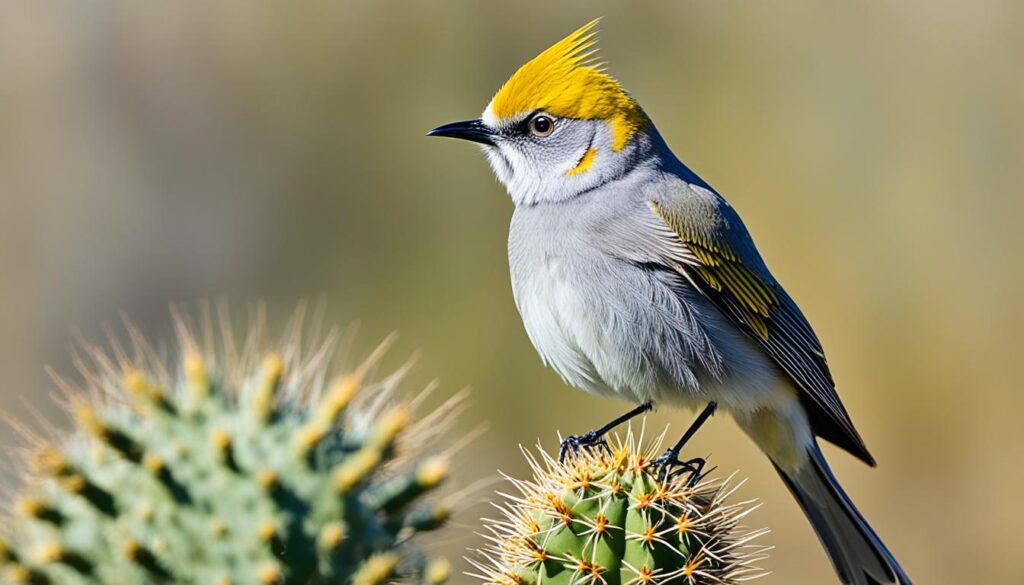
Velvet Scoter
The velvet scoter, a species of diving duck, is found in the boreal forests and freshwater bodies of Northern Europe. These stunning ducks possess a dark, velvety plumage that sets them apart from other waterfowl. Their diet consists of a diverse range of food including crustaceans, marine worms, small fish, and mollusks.
Understanding the distribution and migration patterns of velvet scoters is essential for their conservation. These ducks rely on the boreal forests for nesting and feeding, making these habitats crucial for their survival. By studying their behavior and habitat preferences, researchers can develop effective conservation strategies to protect these unique and beautiful birds.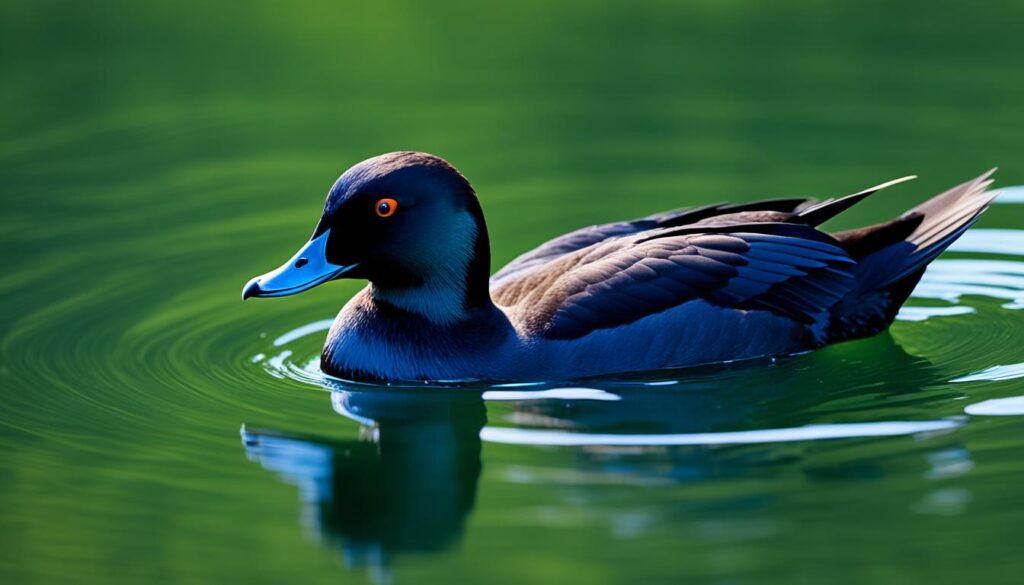
“The velvet scoters are characterized by their striking dark plumage and diving capabilities. Their presence in the boreal forests highlights the importance of preserving these habitats for the conservation of biodiversity.”
Distribution and Migration
Velvet scoters can be found in various freshwater bodies across Northern Europe, from the British Isles to Scandinavia and Russia. During the breeding season, they nest near forested lakes with dense vegetation, providing cover for their nests. As winter approaches, these ducks migrate to coastal areas and estuaries, where they spend the colder months.
To better understand the distribution patterns of velvet scoters, researchers conduct studies using satellite tracking devices and banding programs. These efforts enable scientists to map their migration routes and identify critical stopover sites. Identifying and protecting these areas ensures that velvet scoters have suitable habitats during their migratory journeys.
Conservation Concerns
Boreal forests, with their abundant freshwater bodies, play a vital role in the life cycle of velvet scoters. However, these pristine habitats face numerous threats including deforestation, pollution, and climate change. As a result, velvet scoter populations have experienced declines.
Conservation efforts focused on preserving boreal forests and protecting important habitats for velvet scoters are crucial for their long-term survival. Collaborative initiatives involving governments, conservation organizations, and local communities aim to reduce habitat loss and mitigate the impacts of climate change.
Key Facts about Velvet Scoters
| Common Name | Velvet Scoter |
|---|---|
| Scientific Name | Melanitta fusca |
| Habitat | Boreal forests, freshwater bodies |
| Range | Northern Europe |
| Primary Diet | Crustaceans, marine worms, small fish, mollusks |
| Conservation Status | Least Concern |
Velvet Crab
The velvet crab, also known as the lady crab, is a marine crustacean renowned for its striking blue shell and velvety appearance. These crabs are commonly found in coastal areas, where they inhabit rocky outcrops and crevices along the shoreline. With their distinctive appearance and delicious taste, velvet crabs have become a culinary delicacy, particularly in Spain.

Velvet crabs play an essential role in marine ecosystems as predators, helping to maintain balance by controlling populations of other marine organisms. They feed on a variety of prey, including small fish, mollusks, and other shellfish. Their robust pincers enable them to capture and consume their food with ease.
Here is a table showcasing the key features and characteristics of the velvet crab:
| Common Name | Scientific Name | Habitat | Appearance | Diet |
|---|---|---|---|---|
| Velvet Crab | Liocarcinus puber | Coastal areas | Blue shell with a velvety texture | Small fish, mollusks, other shellfish |
Despite being a culinary delight, it’s important to remember the ecological significance of velvet crabs. By studying their habitat preferences, behaviors, and population dynamics, we can ensure the conservation and sustainability of these important marine crustaceans.
Vampire Squid
The vampire squid, known scientifically as Vampyroteuthis infernalis, is a mesmerizing creature that resides in the deep-sea depths of 2000-3000 meters. This enigmatic cephalopod possesses unique adaptations that allow it to thrive in the harsh conditions of the deep ocean.
One of the most remarkable features of the vampire squid is its bioluminescence. Bioluminescence refers to the ability of certain organisms to produce light. The vampire squid has light-producing organs called photophores, which emit a mesmerizing blue glow. This adaptation serves multiple purposes, including communication, camouflage, and attracting prey.
“The vampire squid uses its bioluminescent display to startle and confuse predators, making it more difficult to see and catch.”
In addition to its bioluminescence, the vampire squid has unique feeding habits. Contrary to its name, the vampire squid does not consume blood like its namesake, but instead survives on a diet of small marine organisms such as plankton and detritus. It uses its specialized feeding apparatus to capture food particles and suspended matter from the water, straining them through delicate, webbed structures known as filaments.
Studying the behavior and adaptations of vampire squids provides valuable insights into the complex web of life that exists in the deep-sea environment. These creatures are a testament to the incredible diversity of life on Earth and highlight the importance of preserving and protecting our oceans.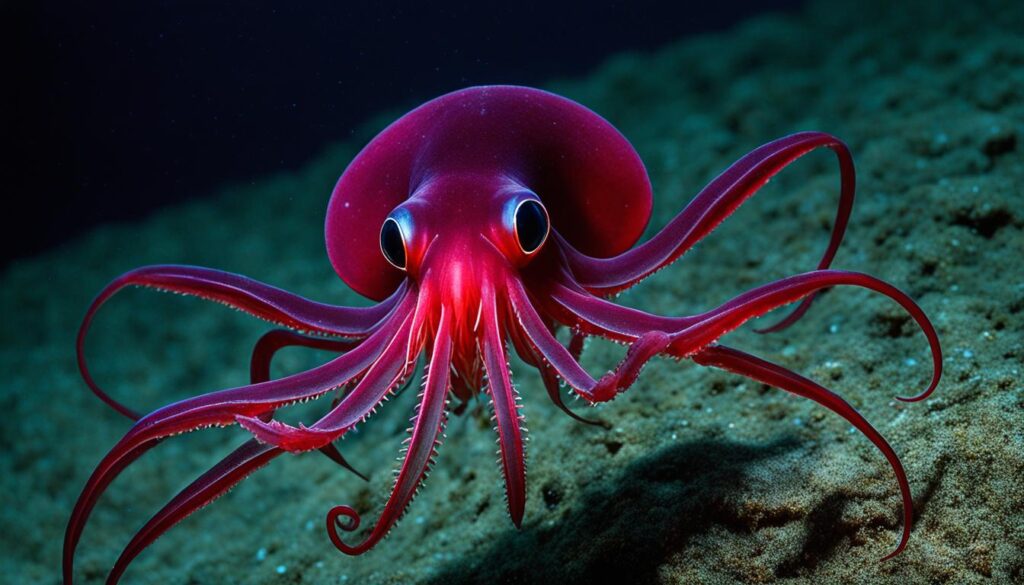
Key Features of the Vampire Squid:
- Deep-sea dweller, inhabiting depths of 2000-3000 meters
- Bioluminescent, emitting a captivating blue glow through photophores
- Feeds on small marine organisms and detritus using specialized feeding structures
- Unique adaptations for survival in the deep-sea environment
Verdin
Verdin birds are small insectivores that thrive in the harsh desert environments of the southwestern United States and northern Mexico. These resilient birds have adapted to survive in arid regions, showcasing remarkable strategies and behaviors. With their insectivorous diets, verdins play a critical role in controlling insect populations in their ecosystems.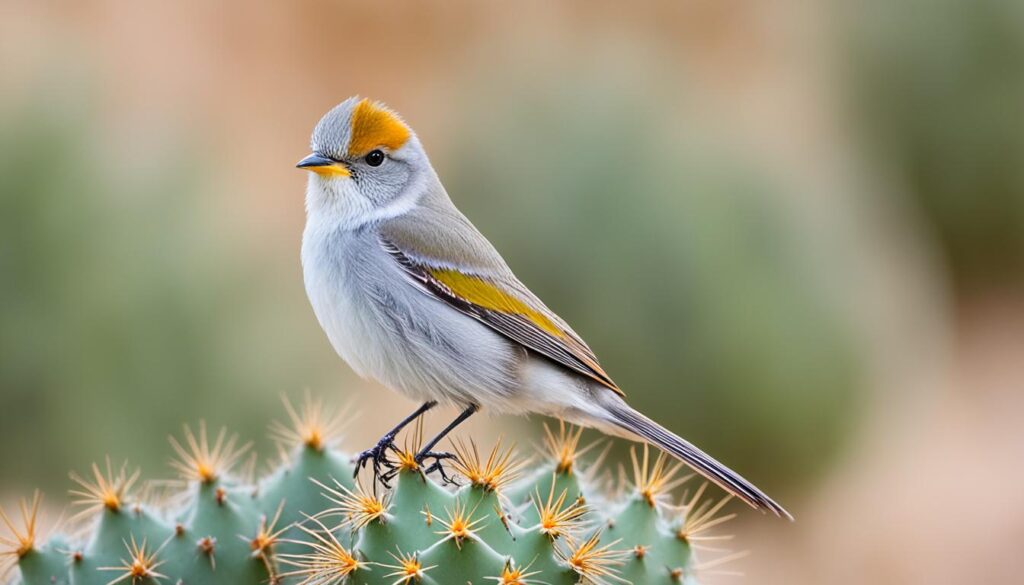
The verdin’s diet primarily consists of insects, including beetles, ants, and caterpillars. However, these resourceful birds are not limited to insects alone. They also consume nectar from desert flowers and feed on small fruits when available.
“Verdins are fascinating creatures that have mastered the art of survival in desert environments. Their ability to find food sources in what seems like barren terrain is truly remarkable.”
To adapt to their desert habitat, verdins have developed unique physiological and behavioral adaptations. Their small size makes them well-suited for navigating through dense vegetation and finding shelter in thorny bushes. Additionally, verdins have intricate nest-building skills, constructing complex structures made of twigs, grass, and spider webs.
“Studying the verdin’s ecology provides valuable insights into the adaptations and strategies employed by birds to thrive in challenging desert environments.”
“These tiny, insectivorous birds are an integral part of desert ecosystems, contributing to the balance of insect populations and supporting the overall health of their habitats.”
Verdin Facts
Here are some fascinating facts about verdins:
- Verdins are one of the few bird species that live exclusively in desert environments.
- They have a distinct song that consists of high-pitched, repetitive notes.
- Verdins are highly social birds, often seen foraging and nesting in small groups.
- They are well-known for their ability to extract water from the food they consume, reducing their reliance on scarce water sources.
By studying verdins and their ecological adaptations, we gain a deeper understanding of how wildlife can thrive in seemingly inhospitable environments. Protecting and preserving the unique desert habitats that verdins call home is crucial for maintaining biodiversity and safeguarding these remarkable species for future generations.
Vervet Monkey
Vervet monkeys are fascinating African primates that hold a special place in the forests and savannas of Africa. With their distinctive black faces and fluffy white and gray hands, they are instantly recognizable. But it’s not just their unique appearance that sets them apart – vervet monkeys are known for their complex social behavior, which adds to their allure and intrigue.
These intelligent creatures live in close-knit groups called troops, consisting of several females with their offspring and a few adult males. Within the troop, vervet monkeys exhibit a well-defined social structure and engage in various social interactions, such as grooming, playing, and vocal communication.
One notable aspect of vervet monkey social behavior is their sophisticated system of communication. They use a range of vocalizations to convey different messages, including alarm calls to warn others of potential threats, location calls to maintain contact while foraging, and dominance calls to establish hierarchy within the troop.
“The vervet monkeys’ vocal communication system is remarkably intricate, with different calls specifically linked to different types of predators or situations,” says Dr. Jane Peterson, a primatologist specializing in African primate behavior.
Beyond their social interactions, vervet monkeys also demonstrate impressive adaptability. They have the ability to thrive in various habitats, including forests, woodlands, and grasslands, allowing them to occupy a broad range of ecosystems throughout Africa.
Studying the structure and dynamics of vervet monkey groups provides valuable insights into the complexity of primate societies and their social behaviors. By understanding their social organization, communication methods, and adaptability, researchers can develop strategies for primate conservation and wildlife management.
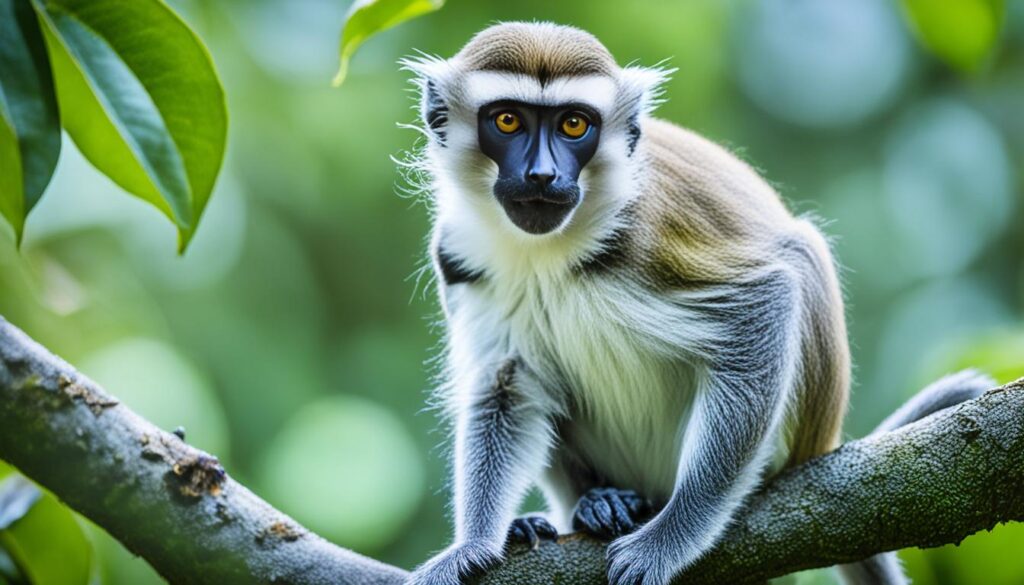
Viperfish
The viperfish is a deep-sea predator that possesses unique adaptations and hunting techniques. With its sharp teeth and bioluminescent photophores, it is well-equipped to thrive in the mysterious world of the deep sea. Let’s explore the fascinating characteristics and behaviors of this extraordinary creature.
“The viperfish’s exceptional adaptations allow it to survive and thrive in the extreme conditions of the deep sea. Its sharp teeth and bioluminescent photophores are essential tools for hunting and attracting prey.”
Adaptations and Behaviors
The viperfish is well-known for its long, fang-like teeth that can be as long as its body. These teeth are angled backward, preventing prey from escaping once caught. To capture its meals, the viperfish relies on its unique hunting technique. It uses its bioluminescent photophores to attract smaller fish and crustaceans, enticing them into close proximity before striking with lightning speed.
Aside from its predatory adaptations, the viperfish has also developed physical characteristics that enable its survival in the deep-sea environment. It possesses a slender body and large eyes, which help it catch faint traces of bioluminescent light emitted by potential prey in the dark depths.
Importance in Deep-Sea Ecosystems
The viperfish plays a significant role in deep-sea ecosystems as a top predator. By regulating the population sizes of their prey, they help maintain a balance within the food chain. Additionally, their feeding behavior contributes to the recycling of nutrients by consuming and breaking down decaying matter.
Exploring the adaptations and behaviors of the viperfish not only enhances our understanding of these unique deep-sea predators, but it also provides valuable insights into the delicate and complex web of life that exists in the depths of our oceans.
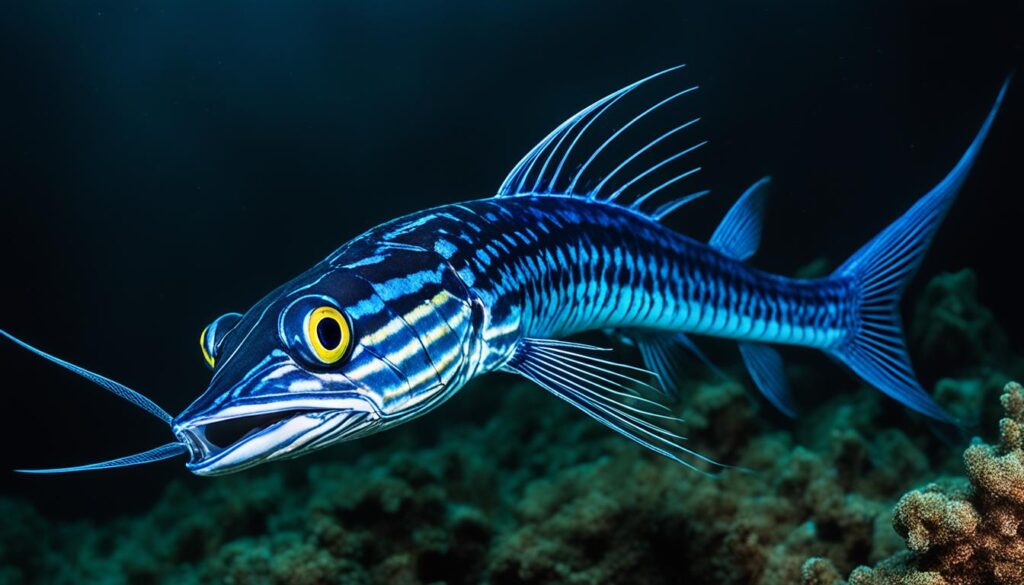
| Common Name | Viperfish |
|---|---|
| Scientific Name | Chauliodus sloani |
| Family | Stomiidae |
| Order | Stomiiformes |
| Habitat | Deep-sea |
| Diet | Crustaceans, small fish |
| Size | Up to 2 feet (61 cm) |
| Depth Range | Up to 13,000 feet (4,000 meters) |
Conclusion
The world of animals that start with V is teeming with an incredible variety of fascinating and vibrant species. Whether they are mammals, birds, reptiles, or insects, these remarkable creatures contribute to the rich biodiversity of our planet. Exploring their unique characteristics, behaviors, and habitats not only expands our knowledge but also deepens our appreciation for the natural world and the importance of conserving these diverse and extraordinary animals.
From the Vancouver Island marmot, a critically endangered mammal indigenous to Canada, to the Verreaux’s sifaka, an agile lemur found in Madagascar’s forests, each species has its own story to tell. The velvety fur of the Vicuna, a graceful member of the camel family in South America, and the tiny size of the volcano rabbit, the world’s smallest bunny, are just some examples of the incredible adaptations found in these creatures.
Not to be forgotten are the vultures, nature’s cleanup crew, the vampire bats that feed on blood, and the verdins with their melodious songs in arid environments. The velvet scoters, vampire squids, vervet monkeys, and viperfish in the depths of the sea also have their own intriguing characteristics and roles within their respective ecosystems.
As we continue to explore the world of animals that start with V, we gain a deeper understanding of the interconnectedness of all life forms and the importance of biodiversity. Each species, no matter how big or small, contributes to the delicate balance of our ecosystems. By protecting and conserving these fascinating animals, we ensure a vibrant and sustainable future for our planet and the generations to come.FAQ
What is a Vancouver Island Marmot?
What is Verreaux’s Sifaka?
What is a Vicuna?
What is a Volcano Rabbit?
What are Vultures?
What are Vampire Bats?
What are Verdins?
What is a Velvet Scoter?
What is a Velvet Crab?
What is a Vampire Squid?
What is a Verdin?
What is a Vervet Monkey?
What are Viperfish?
What are some vibrant animals that start with V?
Dana is our Lead Content Writer, bringing a wealth of knowledge and expertise to our team. With a background deeply rooted in animal studies and a profound love for all creatures, Dana is dedicated to crafting engaging and informative content that resonates with our audience. With Dana at the helm, you can trust that our content is accurate and engaging, catering to the diverse interests of animal enthusiasts everywhere.
Animals
3 Animals Similar to Squirrels
Curious about animals resembling squirrels? Meet chipmunks, marmots, and flying squirrels, each with unique traits that set them apart.

Chipmunks, marmots, and flying squirrels are similar to squirrels. Chipmunks have striped backs and communicate vocally. Marmots are ground-dwellers with bushy tails and hibernate for 8 months. Flying squirrels glide at night with large eyes and a unique membrane. These animals share traits with squirrels, such as agility and adaptability.
Key Takeaways
- Chipmunks share traits with squirrels like agility and varied diet.
- Flying squirrels resemble squirrels in agility and diverse diet.
- Marmots, though different, are diurnal rodents with essential roles in ecosystems.
- All three animals communicate vocally like squirrels for survival.
- Observing these animals in the wild provides insights into behaviors and ecosystem dynamics.
Chipmunks: Small Rodents With Striped Backs
Chipmunks, closely related to squirrels, are small rodents distinguished by the stripes running along their backs. As members of the rodent family, chipmunks exhibit fascinating behaviors that set them apart. These omnivores are active during the daytime, making them a crucial sight in many habitats. Their exceptional climbing abilities allow them to scurry up trees and bushes in search of food, which includes nuts, seeds, fruits, insects, and even small animals.
Communication among chipmunks is crucial for their survival. Through various vocalizations, these small rodents convey messages about potential dangers, food availability, and territorial boundaries. Understanding their intricate language enhances our appreciation for these remarkable creatures.
Next time you spot a chipmunk darting around, take a moment to observe their behaviors and listen to their unique sounds. Chipmunks truly exemplify the beauty of nature's diversity in the animal kingdom.
Marmots: Ground-Dwelling Rodents With Bushy Tails

Marmots, distinguished by their bushy tails, are ground-dwelling rodents that play an essential role in their ecosystems. Belonging to the Sciuridae family, these diurnal creatures are active during the day, using their burrows to live in family groups.
With a weight of up to 11 pounds, marmots have brown fur with white-tipped hair, adapting well to higher altitudes. They hibernate for about 8 months, emerging in spring to forage and reproduce.
In their habitats, marmots influence vegetation dynamics and serve as prey for various predators, contributing significantly to the ecosystem's balance. Observing marmots in the wild can provide insights into their behaviors and interactions with other species, showcasing the importance of these ground-dwelling rodents with their striking bushy tails.
They're fascinating creatures to study due to their unique adaptations and crucial roles within their environments.
Flying Squirrels: Nocturnal Gliding Mammals

Gliding effortlessly through the night, flying squirrels showcase their remarkable ability to navigate the darkness using their unique gliding membrane. These nocturnal mammals are known for their extraordinary gliding skills, allowing them to move gracefully through the air.
With their large, dark eyes providing excellent night vision, flying squirrels can easily maneuver through dimly lit environments like forests where they reside. These omnivorous creatures have a diverse diet, including nuts, seeds, insects, and occasionally bird eggs.
Despite their name, flying squirrels don't truly fly but rather glide by extending their limbs and using the membrane to catch the air, enabling them to travel between trees effortlessly. Their gliding ability sets them apart from other squirrel species, making them fascinating creatures to observe in their natural habitat.
With their adaptation to the night and unique way of moving, flying squirrels offer a glimpse into the innovative ways animals have evolved to thrive in their environments.
Frequently Asked Questions
What Animal Is Similar to Squirrel?
When considering animals similar to squirrels, one might think of the agile chipmunk. This ground-dwelling rodent, like squirrels, boasts bushy tails and climbing prowess. Chipmunks play an essential role in seed dispersal and ecosystem balance, mirroring squirrels' impact.
What Is the Closest Pet to a Squirrel?
The closest pet to a squirrel is a chipmunk. These adorable rodents require care similar to squirrels. Providing a spacious enclosure with climbing opportunities and a diet of nuts, seeds, fruits, and insects guarantees a fulfilling experience.
What Are Squirrels Most Closely Related To?
Squirrels are most closely related to chipmunks, marmots, and prairie dogs. These species within the Sciuridae family share common traits like bushy tails and diurnal habits. Exploring these relationships sheds light on their evolution and adaptations.
What Animals Are in the Same Family as Squirrels?
In the same family as squirrels are chipmunks, prairie dogs, and other fascinating creatures. This diverse Sciuridae family showcases various species with shared evolutionary history. Their roles in ecosystems worldwide highlight their importance for biodiversity and habitat health.
Are There Any Animals Similar to Squirrels That Resemble Possums?
Yes, there are some fascinating species of possum lookalikes that bear a striking resemblance to squirrels. The sugar glider, for example, is a small arboreal possum that shares many physical characteristics with squirrels, such as their bushy tails and similar feeding habits.
Conclusion
Just like the diverse array of animals in the forest, there are many creatures similar to squirrels that share similar characteristics and behaviors.
Chipmunks scurry around with their striped backs, marmots dig into the ground with their bushy tails, and flying squirrels glide through the night sky.
These creatures may be different in appearance, but they all share a common bond with their squirrel cousins in the intricate tapestry of the animal kingdom.
Dana is our Lead Content Writer, bringing a wealth of knowledge and expertise to our team. With a background deeply rooted in animal studies and a profound love for all creatures, Dana is dedicated to crafting engaging and informative content that resonates with our audience. With Dana at the helm, you can trust that our content is accurate and engaging, catering to the diverse interests of animal enthusiasts everywhere.
Chickens
Can Chickens Eat Rhubarb? Safe Feeding Tips
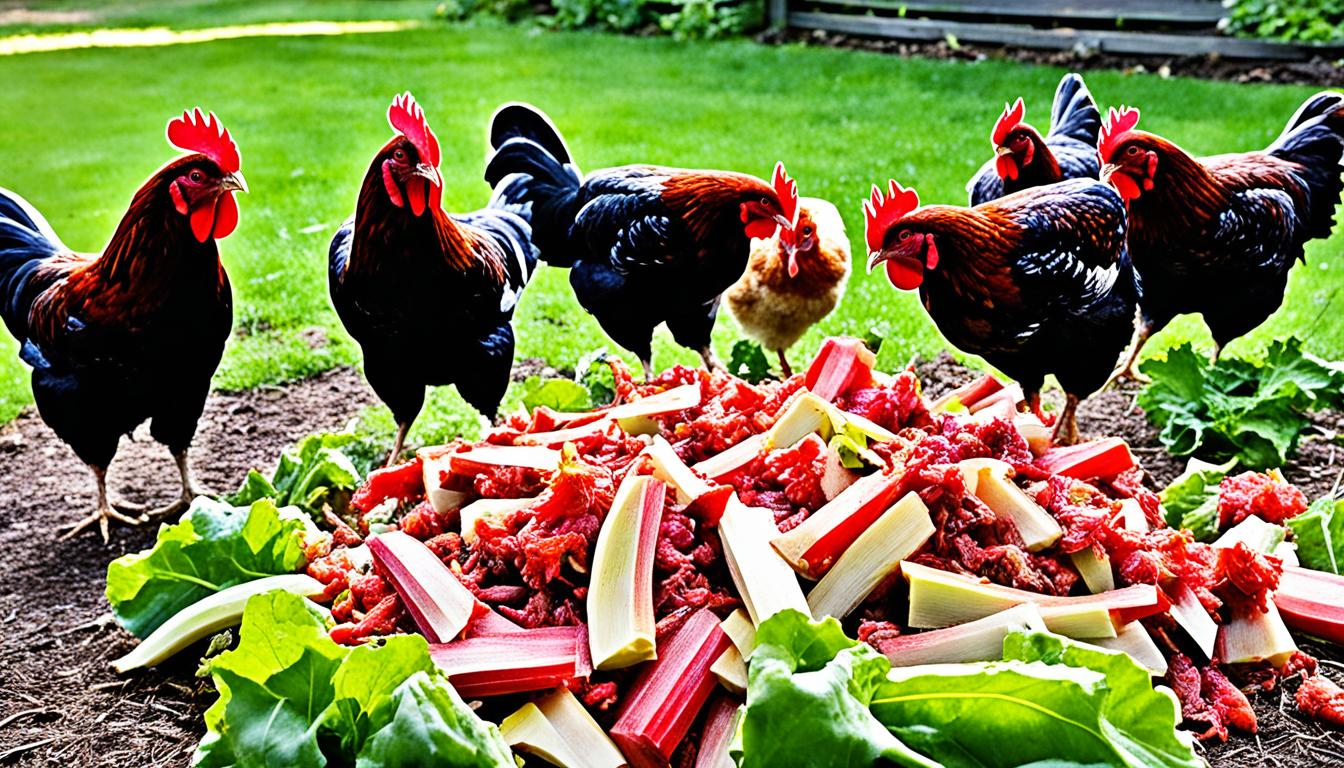
Did you know that chickens are able to consume rhubarb stalks, but they should not eat the leaves?
Chickens are known to enjoy a wide variety of foods, but when it comes to rhubarb, there are some important considerations to keep in mind. While the stalks of rhubarb can provide chickens with valuable vitamins and minerals, the leaves contain oxalic acid, which can be harmful to their health. In this article, we will explore the safe ways to feed chickens rhubarb and the potential risks it may pose.
Key Takeaways:
- Chickens can eat rhubarb stalks in moderation, but the leaves should be avoided due to their oxalic acid content.
- Feeding chickens rhubarb in small amounts can provide them with essential vitamins and minerals.
- Too much sugar in rhubarb, such as in pies or crumbles, can be harmful to chickens.
- It’s crucial to be cautious and only feed chickens rhubarb stalks in tiny amounts fed occasionally.
- Follow the 90/10 feeding rule to ensure a balanced diet for chickens, with rhubarb treats in small quantities.
Can Chickens Eat Rhubarb Stalks?
Chickens can enjoy the deliciousness of rhubarb stalks, but it’s important to feed them in moderation. Rhubarb stalks are a safe and healthy snack for chickens, providing them with essential vitamins and minerals like Vitamin A and Vitamin C, as well as dietary fiber.
To make it easier for your feathered friends to enjoy this treat, cut the rhubarb stalks into bite-size pieces. You can scatter the pieces around their feeding area or mix them in with their regular feed for added variety. Just remember, small amounts are the key to ensuring their well-being.
Rhubarb stalks offer a refreshing crunch and tangy flavor that chickens find irresistible. However, it’s essential to remember that while the stalks are safe for consumption, other parts of the rhubarb plant, such as the leaves, flowers, and seeds, contain oxalic acid and should be strictly avoided as they can be toxic to your chickens.
Providing your chickens with rhubarb stalks as an occasional treat can add nutritional variety to their diet, keeping them happy and healthy. Just be sure to practice moderation and always prioritize their safety.
Health Benefits of Rhubarb Stalks for Chickens
Rhubarb stalks are packed with essential nutrients that can contribute to your chickens’ overall well-being. Here’s a quick rundown of the vitamins and minerals they can gain from enjoying this tasty treat:
| Nutrients | Benefits |
|---|---|
| Vitamin A | Supports healthy vision, immune function, and cellular growth |
| Vitamin C | Acts as an antioxidant, promotes growth, and boosts the immune system |
| Dietary Fiber | Aids in digestion and promotes a healthy digestive system |
Why Can’t Chickens Eat Rhubarb Leaves?
Chickens cannot eat rhubarb leaves due to the high content of oxalic acid. Oxalic acid is a naturally occurring compound found in many plants, including rhubarb leaves. While rhubarb stalks can be safely consumed by chickens in small amounts, the leaves contain a concentrated amount of oxalic acid, which can be toxic to them.
Oxalic acid can lead to kidney failure and can be fatal for chickens if ingested in large quantities. The oxalic acid in rhubarb leaves binds with calcium in the chicken’s body, forming crystals that can cause damage to their kidneys.
It’s crucial to avoid feeding chickens rhubarb leaves, as well as other parts of the rhubarb plant like flowers and seeds, which also contain oxalic acid. Feeding these parts to chickens can put their health at risk.
Effects of Oxalic Acid on Chickens
“The presence of oxalic acid in rhubarb leaves can have severe consequences for chickens’ health. It’s important to be aware of the potential dangers and take necessary precautions.”
The ingestion of oxalic acid in rhubarb leaves can result in symptoms such as weakness, difficulty breathing, trembling, and decreased appetite in chickens. Over time, the crystals formed by the oxalic acid can lead to kidney damage, which may cause kidney failure and other complications.
Chickens should never have access to rhubarb leaves, and it’s crucial to prevent them from consuming these potentially harmful plant parts.
Comparison of Oxalic Acid Content
| Rhubarb Part | Oxalic Acid Content |
|---|---|
| Rhubarb Stalks | Low |
| Rhubarb Leaves | High |
| Rhubarb Flowers | High |
| Rhubarb Seeds | High |
Comparison of oxalic acid content in different parts of the rhubarb plant.
As shown in the table above, rhubarb leaves, flowers, and seeds contain a significantly higher concentration of oxalic acid compared to rhubarb stalks. It’s important to be cautious and ensure that chickens do not have access to these parts of the rhubarb plant.
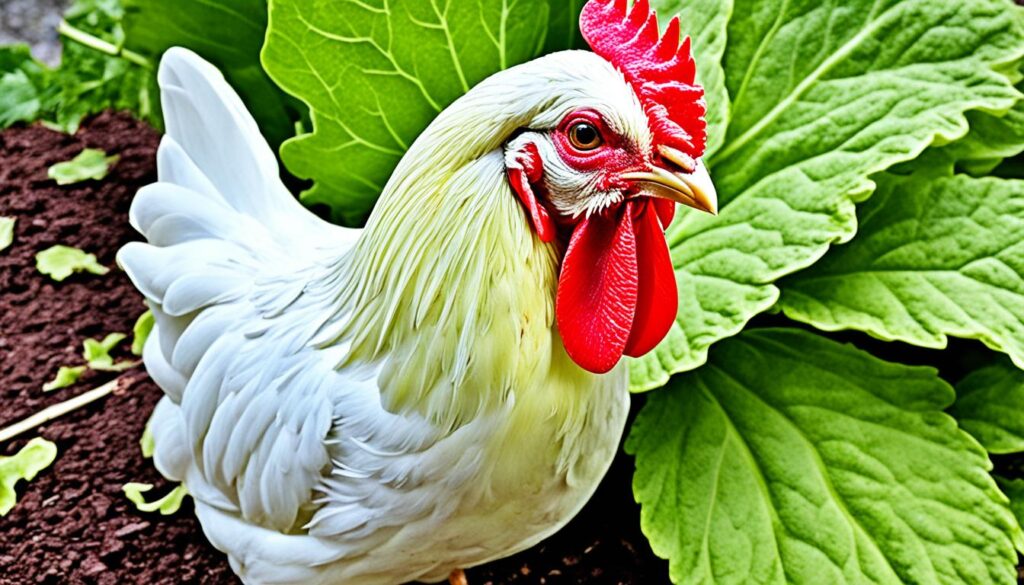
What Happens if Chickens Eat Rhubarb?
When chickens consume rhubarb, it can have detrimental effects on their health. The consequences of chickens eating rhubarb can include:
- Diarrhea: Chickens may experience loose stools or increased bowel movements after consuming rhubarb.
- Abdominal Pain: The oxalic acid present in rhubarb can irritate the digestive system, leading to discomfort and abdominal pain in chickens.
- Lethargy: Chickens may become lethargic, displaying decreased activity levels and reduced energy after ingesting rhubarb.
- Abnormal Behaviors: Eating rhubarb can cause chickens to exhibit abnormal behaviors such as decreased appetite, depression, or reduced vocalization.
It is vital to recognize the signs of rhubarb poisoning in chickens and take immediate action to prevent severe illness or even death. If you suspect your chickens have consumed rhubarb and are displaying any of these symptoms, it is best to seek veterinary care as soon as possible.
“Feeding rhubarb to chickens can lead to diarrhea, abdominal pain, lethargy, and abnormal behaviors.”
It is advisable to avoid feeding rhubarb to chickens altogether as a precautionary measure, considering its potential adverse effects. Instead, focus on offering them a balanced diet that consists of safe and nutritionally appropriate foods.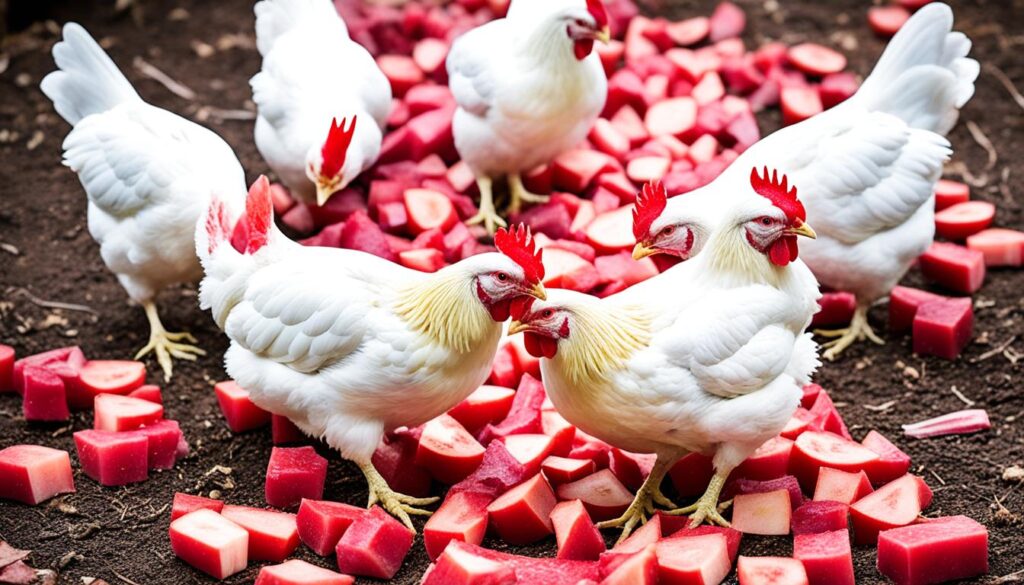
In the table below, you will find a summary of the potential consequences of chickens eating rhubarb:
| Consequences | Description |
|---|---|
| Diarrhea | Loose stools or increased bowel movements |
| Abdominal Pain | Discomfort and pain in the abdominal region |
| Lethargy | Decreased activity levels and reduced energy |
| Abnormal Behaviors | Decreased appetite, depression, or reduced vocalization |
It is crucial to prioritize the well-being of your chickens and make sure to provide them with a diet that is safe and suitable for their nutritional needs. Understanding the potential consequences of feeding rhubarb to chickens can help you make informed decisions and ensure their health and happiness.
How to Treat Rhubarb Poisoning in Chickens?
If your chickens have eaten rhubarb and show signs of poisoning, there are a few home remedies you can try to help alleviate their symptoms and aid in their recovery. Administering a flush can help flush out the toxins from their body and promote healing. Two popular home remedies for rhubarb poisoning in chickens are the Epsom salt flush and the molasses flush.
Epsom Salt Flush
Epsom salt is known for its laxative properties, which can aid in the removal of toxins from the chicken’s system. Here’s how to administer the Epsom salt flush:
- Dissolve 1 tablespoon of Epsom salt in 1 cup of warm water.
- Using a syringe or dropper, gently administer the mixture into the back of the chicken’s throat.
- Ensure the chicken swallows the mixture.
- Repeat the process every 4 to 6 hours, as needed.
Molasses Flush
Molasses acts as a natural laxative and can help flush out toxins from the chicken’s digestive system. Here’s how to administer the molasses flush:
- Mix 1 tablespoon of molasses with 1 cup of warm water.
- Using a syringe or dropper, gently administer the mixture into the back of the chicken’s throat.
- Ensure the chicken swallows the mixture.
- Repeat the process every 4 to 6 hours, as needed.
These home remedies can be effective in treating mild cases of rhubarb poisoning in chickens. However, if the symptoms worsen or persist, it’s important to consult a veterinarian for further guidance and treatment.
It is worth noting that prevention is better than cure when it comes to rhubarb poisoning. It is essential to keep chickens away from rhubarb plants and ensure they have access to a safe and balanced diet. Regularly monitoring their feeding habits and providing appropriate nutrition can help minimize the risk of rhubarb poisoning in chickens.
Nutritional Analysis of Rhubarb for Chickens
When it comes to the nutritional value of rhubarb for chickens, it’s important to understand what this vibrant stalk vegetable provides. Rhubarb stalks contain a variety of essential nutrients that can contribute to the overall health of your chickens. Let’s take a closer look at the vitamins and minerals found in rhubarb that can benefit your feathered friends.
Vitamins in Rhubarb for Chickens
Rhubarb is a good source of several vitamins that are vital for the well-being of chickens. One of the key vitamins found in rhubarb is Vitamin C. This vitamin plays a crucial role in supporting the immune system and promoting overall health. Chickens, just like humans, require Vitamin C to maintain optimal health and combat diseases.
In addition to Vitamin C, rhubarb also contains Vitamin A. This vitamin is essential for maintaining healthy vision, promoting growth and development, and supporting the reproductive system. Vitamin A is crucial for chickens’ overall well-being and can contribute to their overall vitality.
Minerals in Rhubarb for Chickens
Rhubarb is not just a source of vitamins but also provides vital minerals that can benefit chickens. One of these minerals is calcium. Calcium is essential for maintaining strong bones and eggshell production in hens. Including rhubarb in your chickens’ diet can help fulfill their calcium requirements and contribute to their overall skeletal health.
Another important mineral found in rhubarb is iron. Iron is necessary for the production of healthy red blood cells, which help transport oxygen throughout the body. By incorporating rhubarb into their diet, you can help ensure your chickens receive adequate iron levels to support their overall well-being.
Furthermore, rhubarb contains potassium, a mineral that plays a vital role in regulating fluid balance, muscle function, and nerve signals. Including rhubarb as a part of your chickens’ diet can help maintain these essential functions and support their overall health and vitality.
It’s important to note that while rhubarb can provide certain vitamins and minerals beneficial to chickens, it should be fed in moderation. Rhubarb stalks also contain a relatively high sugar content, which can be harmful if consumed in excess. Therefore, it’s crucial to ensure that rhubarb is offered as a treat rather than a staple part of their diet.
Overall, rhubarb can be a nutritious addition to your chickens’ diet when fed responsibly and in appropriate amounts. Its vitamin and mineral content, including Vitamin C, Vitamin A, calcium, iron, and potassium, can contribute to their overall health and well-being. Remember to always provide rhubarb in moderation and prioritize a balanced diet for your feathered friends.
| Nutrient | Amount per 100g of Raw Rhubarb Stalks |
|---|---|
| Vitamin C | 13.8 mg |
| Vitamin A | 102 IU |
| Calcium | 86 mg |
| Iron | 0.22 mg |
| Potassium | 288 mg |
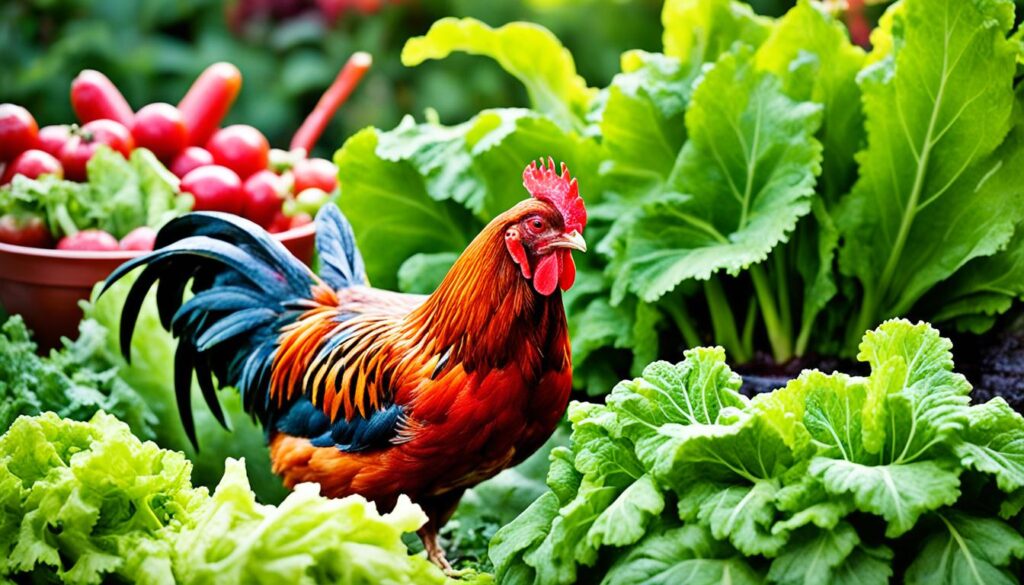
- USDA FoodData Central: Rhubarb, raw. (2021, May 31).
- Raising Happy Chickens: Understanding and Caring for Chickens’ Nutritional Needs.
Best Plants to Feed Chickens
Chickens love to explore and peck at a variety of plants. While their main diet should consist of complete feeds, offering them safe plants as treats can be enjoyable for them. Here are some plants that chickens can eat:
- Lettuce
- Beets
- Broccoli
- Carrots
- Kale
- Mint
- Parsley
These plants provide additional nutrients and flavors to their diet. Chickens can enjoy small quantities of these plants as an occasional snack. However, it’s important to note that while these plants are safe, they should still be offered in moderation. Too much of any plant can upset their digestive system.
It’s crucial to avoid feeding chickens toxic plants that can harm their health. Some plants to avoid feeding chickens include:
- Onions
- Raw beans
These plants can be toxic to chickens and should be kept away from their reach. Always prioritize their safety and well-being when offering plants as treats.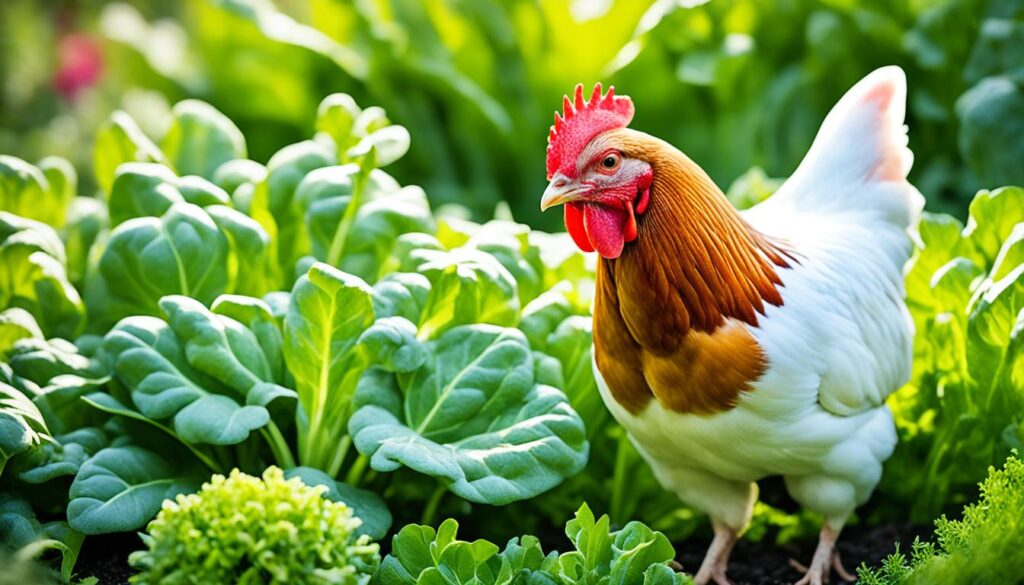
Note: Keep in mind that the plant suggestions provided here are not an exhaustive list. It’s always important to do thorough research and consult with poultry experts to ensure the plants you offer to your chickens are safe and appropriate for their consumption.
Worst Plants to Avoid Feeding Chickens
When it comes to feeding chickens, it’s important to be aware of the plants that can be toxic and dangerous to them. Certain plants can cause various health issues and even be fatal if consumed by chickens. Here are some of the worst plants that you should avoid feeding your chickens:
- Onions: Onions contain compounds that can lead to anemia and liver problems in chickens. It’s best to keep onions away from their diet to ensure their well-being.
- Raw beans: Raw beans contain a compound called hemagglutinin, which can be harmful to chickens. It can interfere with digestion and nutrient absorption, causing digestive issues and other health problems.
- Avocados (except for the flesh): While avocados themselves are not toxic to chickens, the leaves, bark, and pit contain a substance called persin, which can be harmful. It’s important to only offer chickens the flesh of avocados and avoid feeding them any other parts of the plant.
- Moldy or rotten foods: Moldy or rotten foods can contain harmful molds and bacteria that can cause digestive issues and other health problems in chickens. It’s important to ensure that the food you offer your chickens is fresh and free from any signs of spoilage.
- Very salty foods: Excessive salt can be detrimental to a chicken’s health, leading to electrolyte imbalances and dehydration. It’s best to avoid feeding them very salty foods to maintain their well-being.
By being aware of these plants and avoiding them in your chickens’ diet, you can help keep them safe and healthy. It’s always a good idea to research and consult with experts to ensure that you are providing the best diet for your feathered friends.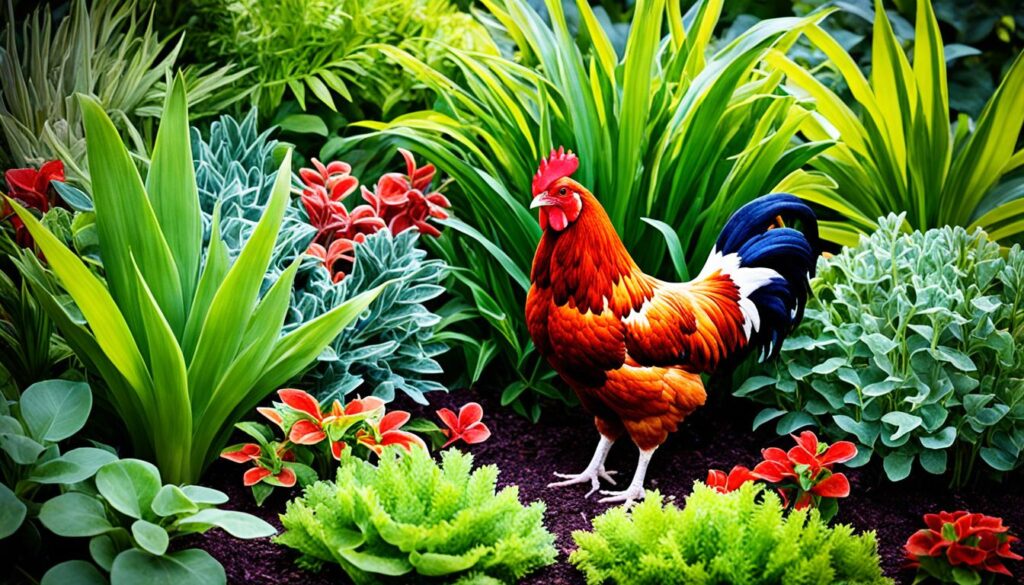
| Plants | Potential Health Issues |
|---|---|
| Onions | Anemia, liver problems |
| Raw beans | Digestive issues, nutrient absorption problems |
| Avocados (except for the flesh) | Persin toxicity |
| Moldy or rotten foods | Digestive issues, bacterial infections |
| Very salty foods | Electrolyte imbalances, dehydration |
How to Keep Chickens Safe from Rhubarb Plants
To protect your chickens from rhubarb plants, it’s important to take certain precautions and create a safe environment. Follow these tips to ensure the well-being of your feathered friends:
1. Gate off Areas with Rhubarb Plants
Start by securing the areas where rhubarb plants are growing. Install sturdy fencing or use chicken wire to create a barrier around the plants. This will prevent chickens from accessing the rhubarb and potentially ingesting the harmful parts.
2. Restrict Access to Gardens
In addition to gating off the rhubarb plants, restrict your chickens’ access to gardens where rhubarb may be present. Utilize fences, netting, or other forms of physical barriers to keep them out of these areas. This will prevent accidental ingestion or nibbling on rhubarb stalks.
3. Separate or Remove Toxic Plants
Along with rhubarb, there may be other toxic plants in your garden that can harm chickens. Take the time to identify and remove or separate these plants from the areas where your chickens roam. This precaution will further minimize the risk of exposure to harmful vegetation.
4. Create a Chicken-Friendly Garden
Consider creating a dedicated chicken-friendly garden where your chickens can freely explore and forage. Plant safe and nutritious vegetation, such as lettuces, beets, kale, and herbs like mint and parsley. This provides an alternative and safe environment for your chickens to enjoy without the risk of encountering harmful plants.
5. Avoid Planting Rhubarb
If you have chickens or other pets and animals, it’s best to avoid planting rhubarb altogether. By eliminating rhubarb from your garden, you eliminate the potential danger it poses to your chickens. Instead, focus on cultivating plants that are safe and beneficial for your feathered companions.
By following these guidelines, you can ensure the safety of your chickens and protect them from the potential hazards of rhubarb plants. Remember, prevention is key when it comes to keeping your chickens healthy and happy!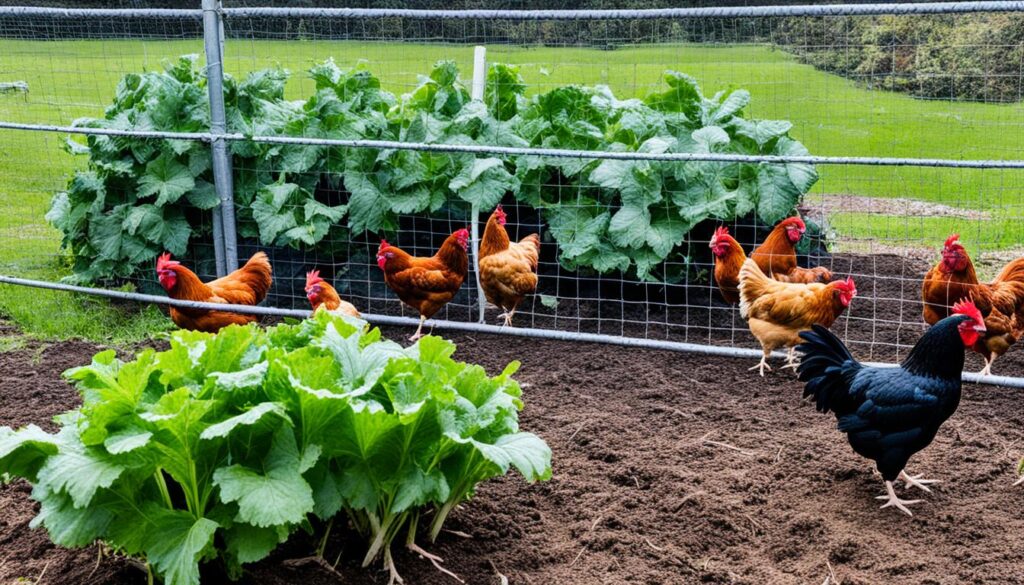
| Harmful Plants | Safe Plants |
|---|---|
| Rhubarb leaves | Lettuce |
| Onions | Beets |
| Raw beans | Kale |
| Avocado (except for flesh) | Mint |
| Moldy or rotten foods | Parsley |
| Very salty foods |
90/10 Feeding Rule for Chickens
When it comes to feeding chickens, maintaining a balanced diet is essential for their health and well-being. The 90/10 feeding rule provides a guideline on how to achieve this balance. According to this rule, 90% of a chicken’s diet should consist of complete feed, while the remaining 10% can be treats and other food sources.
Complete feeds are specially formulated to provide chickens with all the necessary nutrients they need to thrive. These feeds typically contain a balanced combination of grains, proteins, vitamins, and minerals, ensuring that your feathered friends receive a well-rounded diet. By offering complete feed as the main component of their diet, you are providing a solid foundation for their nutritional needs.
On the other hand, the remaining 10% of a chicken’s diet can be allocated to treats and supplementary food sources. Treats can come in the form of kitchen scraps, vegetables, fruits, or even insects that your chickens can forage for. However, it’s important to note that treats should be given in moderation to avoid overfeeding and upsetting the balance of their diet.
Following the 90/10 rule ensures that chickens receive the necessary nutrients from their complete feed while still enjoying the occasional treat. It’s important to resist the temptation to go overboard with treats, as excessive indulgence can lead to dietary imbalances and unbalanced growth in chickens.
Remember, a balanced diet is vital for a chicken’s overall health, ensuring they receive the right nutrients to support their immune system, feather quality, and egg production.
By adhering to the 90/10 feeding rule, you can be confident that your chickens are receiving a nutritionally balanced diet. Not only does this promote their well-being, but it also contributes to their optimal growth and development.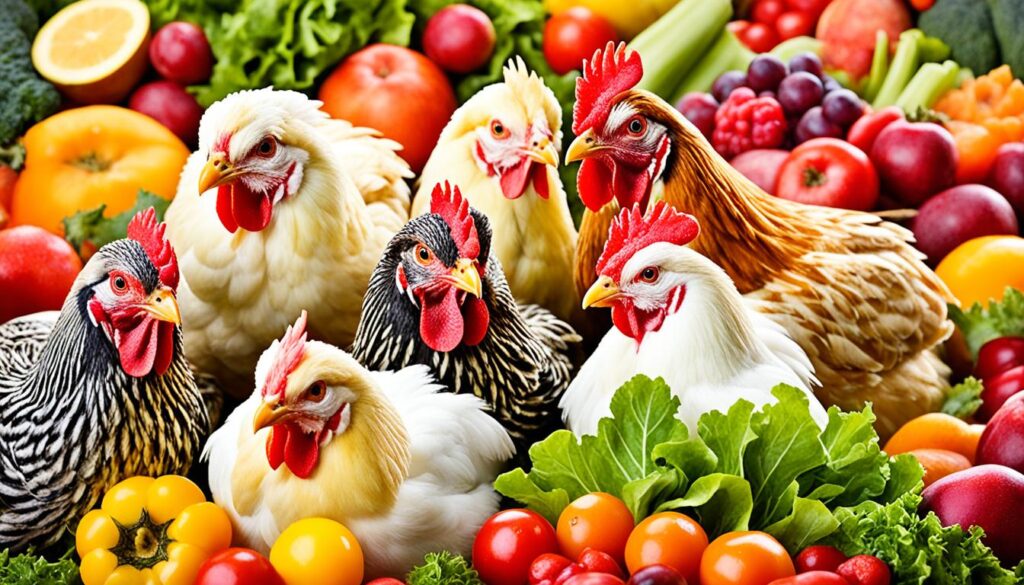
The Benefits of the 90/10 Feeding Rule:
- Provides a balanced diet with essential nutrients
- Promotes healthy growth and development
- Reduces the risk of dietary imbalances
- Maintains optimal egg production and feather quality
- Prevents overfeeding and obesity
Foods That Increase Chicken’s Appetite
If your chickens are experiencing a decreased appetite, it’s important to find ways to stimulate their appetite and encourage them to eat. By offering certain foods known to increase a chicken’s appetite, you can help them regain their strength and ensure they are getting the necessary nutrition. Here are some appetite-stimulating foods for chickens:
- Hard-boiled eggs: Eggs are a rich source of protein and can be a highly enticing treat for chickens. Chop the eggs into small pieces and offer them as a snack.
- Cooked vegetables: Vegetables like carrots, peas, sweet potatoes, and green beans can be cooked and mashed or chopped to create a soft and easy-to-eat meal for chickens.
- Cooked meat: Leftover cooked meat, such as chicken or turkey, can be shredded and added to their regular feed or offered as a separate treat. Make sure to remove any bones before feeding.
- Herbs: Fresh herbs like parsley, basil, and oregano can help enhance the flavor of their feed and entice chickens to eat. Chop the herbs finely and sprinkle them over their food.
- Electrolytes: Electrolyte solutions designed for chickens can help replenish lost nutrients and stimulate their appetite. Follow the recommended dosage instructions provided by the manufacturer.
- Supplements: There are specific supplements available in the market that can boost a chicken’s appetite. Consult with a veterinarian or poultry specialist to determine the best supplement for your chickens.
Remember, it’s important to introduce these appetite-stimulating foods gradually and in moderation. Observe your chickens’ response and adjust the quantities accordingly. Offering a varied and balanced diet with these appetite-boosting foods can help improve your chickens’ appetite and overall well-being.
Nutritional Analysis of Appetite-Stimulating Foods
Here is a nutritional analysis of the appetite-stimulating foods mentioned above:
| Food | Nutrients |
|---|---|
| Hard-boiled eggs | Protein, vitamin A, vitamin D, vitamin B12 |
| Cooked vegetables | Fiber, vitamins (A, C, K), potassium |
| Cooked meat | Protein, iron, zinc, vitamin B12 |
| Herbs | Antioxidants, vitamins, minerals |
| Electrolytes | Essential minerals (sodium, potassium, magnesium) |
| Supplements | Varies depending on the supplement |

Offering these foods to your chickens can provide nutritional benefits and help increase their appetite. However, it’s important to remember that a balanced diet is crucial for their overall health. Consult with a veterinarian or poultry nutritionist to ensure you are providing a well-rounded diet that meets their nutritional needs.
Conclusion
In conclusion, it is safe for chickens to eat rhubarb stalks in moderation. However, they should avoid consuming the leaves, flowers, and seeds of the rhubarb plant due to their high oxalic acid content. While rhubarb stalks can provide chickens with beneficial vitamins and minerals, it is important to feed them in small amounts as part of a balanced diet.
Adhering to the 90/10 feeding rule is crucial for maintaining the health of chickens. This rule suggests that 90% of their diet should consist of complete feeds, while the remaining 10% can include treats and supplemental foods like rhubarb stalks. By following this rule, chicken owners can ensure that their feathered friends receive adequate nutrition without overindulging in potentially harmful treats.
Furthermore, it is essential to prioritize the safety of chickens by preventing access to toxic plants like rhubarb. This can be achieved by gating off areas where rhubarb grows and planting chicken-friendly gardens with safe plant options. By creating a secure environment, chicken owners can minimize the risk of accidental consumption of harmful plants and keep their chickens healthy and thriving.FAQ
Can chickens eat rhubarb stalks?
Why can’t chickens eat rhubarb leaves?
What happens if chickens eat rhubarb?
How to treat rhubarb poisoning in chickens?
What is the nutritional analysis of rhubarb for chickens?
What are the best plants to feed chickens?
What are the worst plants to avoid feeding chickens?
How to keep chickens safe from rhubarb plants?
What is the 90/10 feeding rule for chickens?
What are some foods that increase a chicken’s appetite?
Laura is a versatile writer and editor whose passion for animals shines through in her work. With a keen understanding of language and a love for storytelling, Laura crafts compelling narratives that captivate our audience and inspire action regarding animal welfare. Whether she’s delving into the latest research or sharing heartwarming stories of animal companionship, Laura’s work will leave a lasting impression on all who read it.
Chickens
Can Chickens Eat Persimmons? Safe Feeding Tips
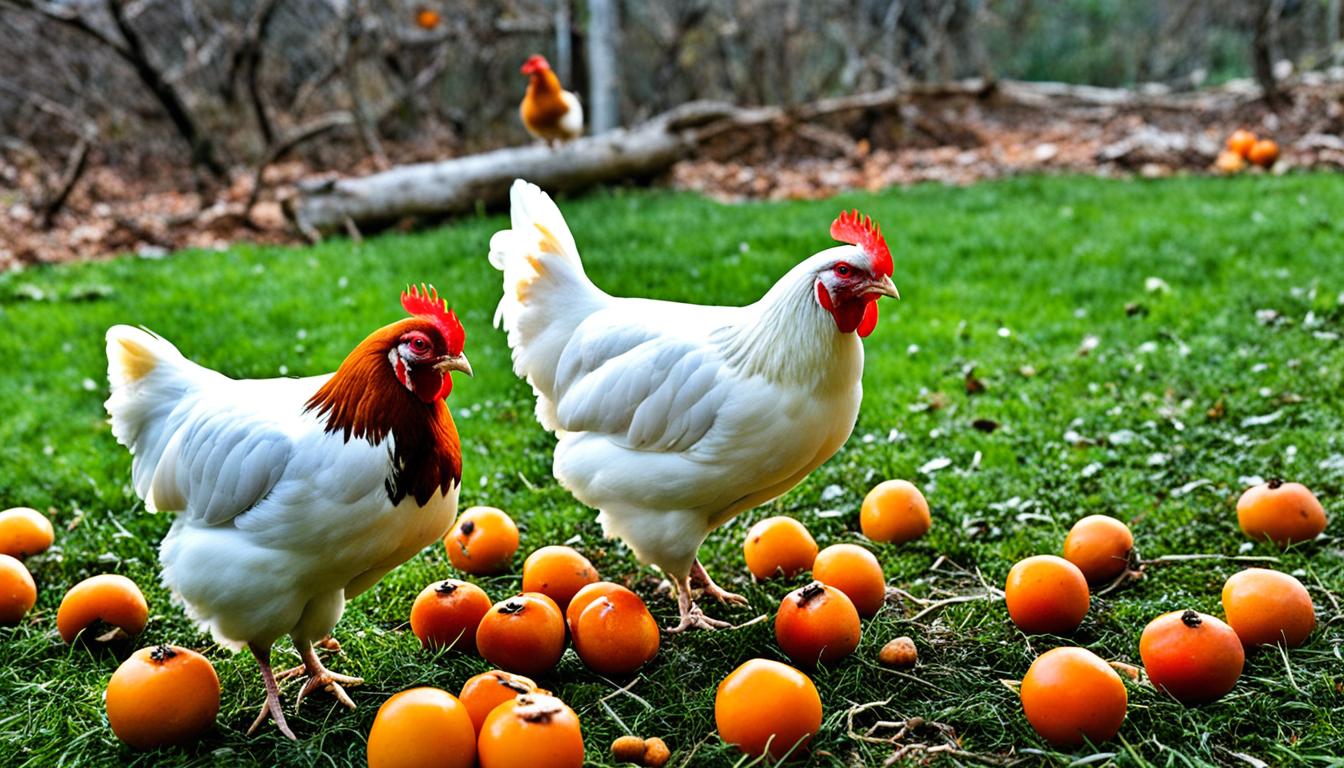
Did you know that chickens can indulge in a diverse range of fruits? Surprisingly, chickens can also enjoy persimmons! These tasty fruits not only give your feathered friends a delicious snack but also provide important nutrients to keep them healthy. However, before you start giving persimmons to your flock, it’s important to learn the proper feeding guidelines to keep them safe and well.
Key Takeaways:
- Chickens can safely eat persimmons in moderation.
- Persimmons provide a vitamin boost, especially during the cold winter months.
- It’s important to limit persimmon intake due to their high sugar content.
- Introduce persimmons gradually to chickens and observe their reactions.
- Consult with a veterinarian for personalized advice on feeding persimmons to your flock.
Persimmons: A Berry for Chickens
When it comes to feeding chickens, the options can sometimes seem limited. However, one fruit that can provide a tasty and nutritious addition to their diet is the persimmon. Whether it’s the Fuyu, Hachiya, or American variety, persimmons are considered a type of berry that chickens can safely enjoy.
Persimmons come in different sizes and colors, ranging from yellow to dark red or orange. This vibrant range adds visual appeal to the chickens’ diet while providing a delectable treat. Chickens are likely to enjoy the sweet and succulent taste of persimmons, making it a popular choice among poultry enthusiasts.
However, it’s important to exercise moderation when feeding persimmons to chickens. Just like other fruits with a high sugar content, persimmons should be given in limited amounts to avoid overindulgence. While chickens can benefit from the vitamins and nutrients found in persimmons, it’s crucial to maintain a balanced diet and not rely solely on this fruity delicacy.
Nutritional Benefits of Persimmons for Chickens
Persimmons offer several nutritional benefits for chickens. They are rich in vitamins, including vitamin A, vitamin C, and vitamin B6. These vitamins support the immune system, promote healthy skin, and boost metabolism. Persimmons also contain folate, thiamin, riboflavin, manganese, and other essential minerals that are vital for the overall health and well-being of chickens.
When chickens consume persimmons, they receive a nutritious and delicious treat that can supplement their regular feed. These vibrant fruits provide a natural source of vitamins and minerals, which are crucial for their growth, development, and overall vitality.
Vitamins in Persimmons
Persimmons are particularly rich in vitamins that offer a range of health benefits for chickens. Let’s take a closer look at the key vitamins found in persimmons and their roles in supporting chickens’ health:
1. Vitamin A
Vitamin A plays a crucial role in maintaining a strong immune system, enhancing vision, and promoting healthy skin and feathers in chickens. It also supports their reproductive health and improves their overall resistance to diseases.
2. Vitamin C
Vitamin C acts as a powerful antioxidant, protecting chickens’ cells from damage caused by free radicals. It also plays a vital role in collagen synthesis, which is essential for healthy skin, bones, and connective tissues.
3. Vitamin B6
Vitamin B6 is involved in various metabolic processes in chickens, including protein synthesis and red blood cell production. It also supports their nervous and immune systems, contributing to their overall health and vitality.
In addition to these key vitamins, persimmons contain other essential nutrients, including folate, thiamin, riboflavin, and manganese. These nutrients play important roles in various bodily functions, such as energy production, DNA synthesis, and bone health in chickens.
However, it’s important to feed persimmons in moderation to avoid oversupplying these nutrients and disrupting the chickens’ balanced diet. Too much of a good thing can be harmful, so it’s crucial to maintain a proper balance between persimmons and their regular feed.
To ensure chickens receive the nutritional benefits of persimmons without overindulging, it’s recommended to offer them small quantities of persimmons as occasional treats. This way, chickens can enjoy the delicious flavor and reap the rewards of the vitamins and minerals found in these delightful fruits.
| Vitamin | Function |
|---|---|
| Vitamin A | Enhances immune system, promotes healthy skin and feathers |
| Vitamin C | Acts as an antioxidant, improves skin health, and supports collagen synthesis |
| Vitamin B6 | Aids in metabolism, protein synthesis, and immune system function |
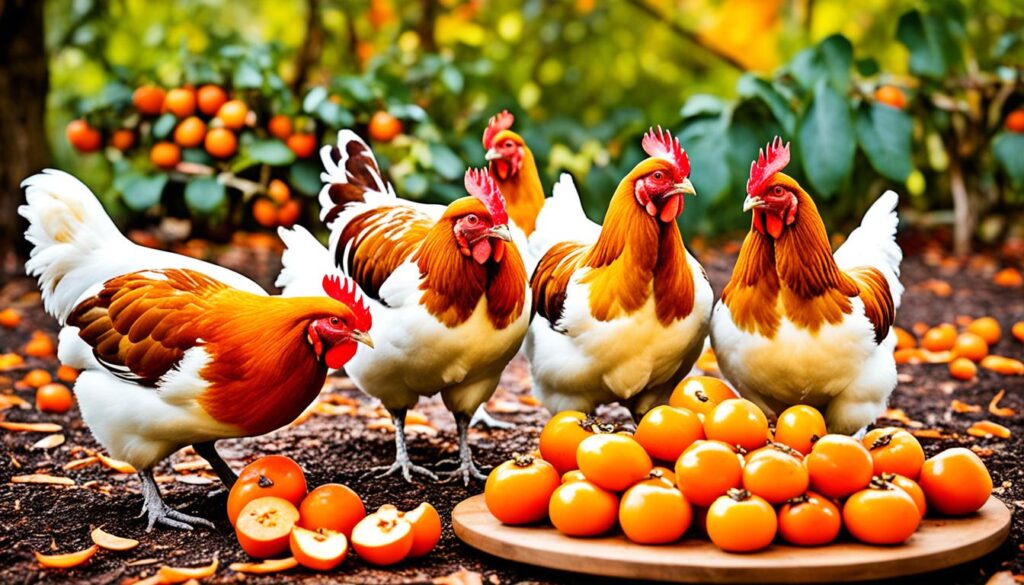
By including persimmons as part of a varied and balanced diet, chickens can enjoy the nutritional benefits of these vibrant fruits while leading healthy and active lives.
Feeding Persimmons to Chickens
To introduce persimmons to chickens, it’s important to start slowly and observe their reaction. Chickens may be hesitant to try new foods, so gradual introduction is key. One effective method is to hang a piece of persimmon in the chicken coop, allowing them to examine it before giving it a try. The soft skin and flesh of persimmons make them easy for chickens to consume, so there’s no need to cut them into small pieces or remove the skin.
Feeding Tips:
- Start by offering small pieces of persimmon.
- Observe the chickens’ reaction and appetite.
- Gradually increase the quantity of persimmons over time.
- Ensure persimmons are ripe and fresh for the best taste.
Once your chickens are accustomed to persimmons, you can make the feeding experience more enjoyable by cutting the fruit into different shapes or even hiding pieces for them to find. This adds a fun and stimulating element to their diet.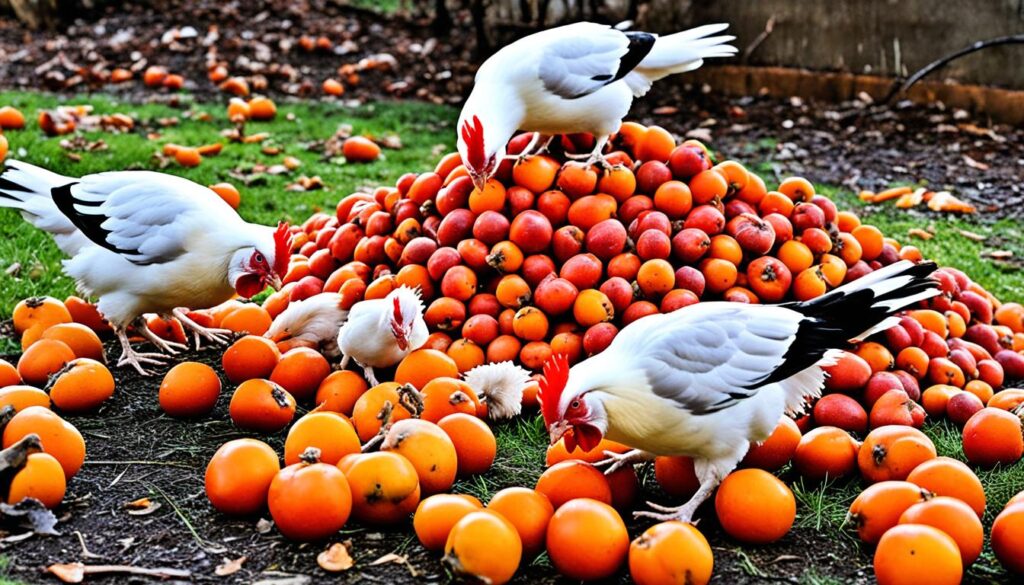
Remember, while persimmons are a healthy treat, they should be given in moderation to maintain a balanced diet for the chickens.
Potential Drawbacks of Persimmons for Chickens
While persimmons are generally safe for chickens to consume, there are a few potential drawbacks and risks associated with feeding persimmons to them. It’s essential for chicken owners to be aware of these considerations to ensure the well-being and health of their flock.
High Sugar Content: One concern when it comes to feeding persimmons to chickens is their high sugar content. Persimmons are naturally sweet fruits, and excessive consumption of high-sugar foods can lead to various health issues for chickens. It is crucial to moderate the quantity of persimmons and avoid feeding them in large quantities to prevent blood sugar imbalances and weight gain.
Health Conditions: Chickens with certain health conditions, such as diabetes or obesity, should be cautious when consuming persimmons. The high sugar content in persimmons can exacerbate these conditions and potentially lead to further health complications. It is advisable to consult with a veterinarian for specific dietary guidelines if your chickens have pre-existing health conditions.
Potential Intestinal Blockages: Another risk associated with persimmons for chickens is the presence of seeds. Persimmon seeds contain tannins, which can clump together and potentially lead to intestinal blockages if chickens consume them excessively. It’s crucial to monitor chickens’ intake and ensure that they don’t overindulge in persimmon seeds, reducing the risk of digestive problems and blockages.
Did You Know? Chickens have a gizzard, which helps them grind and digest their food. However, the seeds of fruits like persimmons can be challenging for a chicken’s digestive system to break down, increasing the risk of blockages.
| Drawbacks of Persimmons for Chickens | Risks of Feeding Persimmons to Chickens |
|---|---|
| High sugar content | Potential blood sugar imbalances |
| Health conditions (diabetes, obesity) | Potential exacerbation of existing health conditions |
| Presence of tannin in seeds | Potential intestinal blockages |
By being cautious and monitoring the quantity and frequency of persimmon feedings, chicken owners can minimize the drawbacks and risks associated with feeding persimmons to their flock. It is always recommended to provide a balanced and varied diet for chickens, consulting with a veterinarian if necessary, to ensure their overall health and well-being.
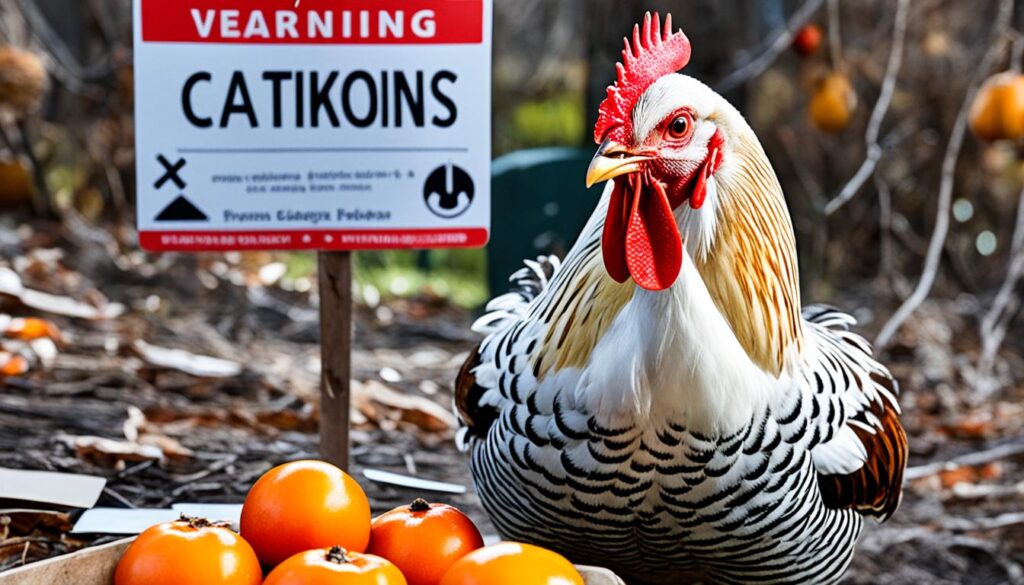
Feeding Persimmon Leaves to Chickens
Chickens can enjoy the benefits of persimmon leaves as part of their diet, but it’s important to offer them in moderation. Persimmon leaves provide fiber and other nutrients that can contribute to the overall digestion and well-being of your chickens.
Before giving persimmon leaves to your chickens, make sure to wash them thoroughly to remove any potential contaminants. Wilted or spoiled leaves should be avoided since they may contain toxins that could be harmful to your chickens.
When introducing persimmon leaves to your chickens for the first time, start with a small quantity and observe their reaction. Some chickens may have preferences, while others may take time to adjust to this new treat. Gradually increase the amount based on their response.
Feeding persimmon leaves to your chickens can be an excellent way to add variety to their diet, allowing them to enjoy the benefits of different nutrients. While persimmon leaves are generally safe for chickens, it’s always essential to monitor their diet and consult with a veterinarian for personalized advice.
Benefits of Persimmon Leaves for Chickens
Persimmon leaves offer several advantages for chickens. They are a rich source of fiber, which aids in digestion and promotes a healthy gut. Additionally, these leaves contain essential minerals and vitamins, such as potassium, manganese, and vitamin C, which contribute to the overall well-being and immune system of your chickens.
The fiber in persimmon leaves can help regulate bowel movements and prevent digestive issues in chickens. It assists in maintaining a healthy and balanced digestive system, allowing your chickens to better absorb nutrients from their food.
The table below highlights some of the key nutritional values of persimmon leaves:
| Nutrient | Amount per 100g |
|---|---|
| Fiber | 6g |
| Potassium | 214mg |
| Calcium | 81mg |
| Manganese | 1.5mg |
| Vitamin C | 43mg |
Remember, while persimmon leaves are beneficial for chickens, it’s important to offer them as part of a diverse diet that includes other healthy food options. Providing a balanced diet is key to maintaining the overall health and happiness of your flock.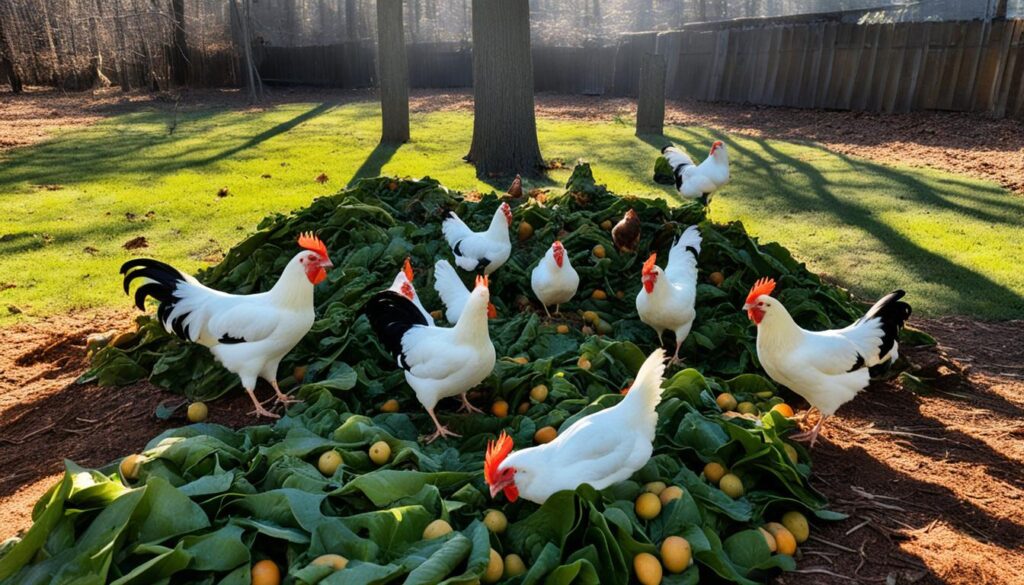
Remember to always introduce new foods gradually and keep a close eye on your chickens’ reaction. By offering persimmon leaves in moderation, you can provide your chickens with a nutritious and enjoyable addition to their diet.
Foods to Avoid Giving Chickens
While chickens can enjoy a variety of foods, it’s important to be aware of the foods that are toxic or harmful to them. By avoiding these foods, you can ensure the health and well-being of your chickens. Some of the foods that should be kept away from chickens include:
- Chocolate: Chocolate contains theobromine, which is toxic to chickens and can lead to symptoms like increased heart rate and tremors.
- Avocado: Avocado contains persin, a toxin that can be lethal to chickens if ingested in large quantities. It’s best to completely avoid feeding avocados to chickens.
- Lemons and oranges: Citrus fruits like lemons and oranges are highly acidic, which can upset the digestive system of chickens. While small amounts can be given as an occasional treat, it’s best to limit their intake.
- Processed foods: Foods that are high in salt, sugar, or artificial additives should be avoided. These can be harmful to chickens and can lead to various health issues.
Instead of these toxic or unhealthy foods, focus on offering safe and nutritious options for your chickens. Here are some examples:
- Vegetables: Leafy greens, carrots, peas, and cucumbers are all excellent choices for chickens. These vegetables provide essential vitamins and minerals.
- Fruits: Safe fruits for chickens include apples, berries, and watermelon. These fruits offer natural sweetness and hydration.
- Grains: Whole grains like oats and rice can be given to chickens in small amounts for added nutrition.
- Protein-rich options: Eggs or mealworms are great sources of protein for chickens. These can be offered as treats to supplement their diet.
By avoiding toxic foods and focusing on safe and nutritious options, you can ensure that your chickens stay healthy and happy.
| Toxic Foods for Chickens | Safe and Nutritious Alternatives |
|---|---|
| Chocolate | Vegetables: leafy greens, carrots, peas |
| Avocado | Fruits: apples, berries, watermelon |
| Lemons and oranges | Grains: oats, rice |
| Processed foods | Protein-rich options: eggs, mealworms |
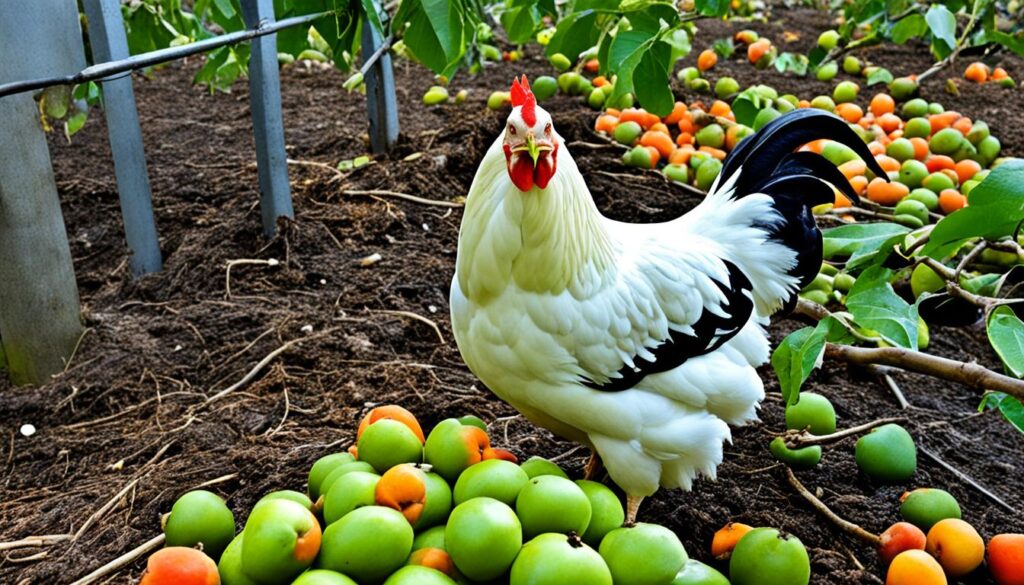
Can Chickens Eat Persimmons Skin?
Chickens can safely enjoy persimmon skins as part of their diet, as long as the skin is clean and free from pesticides. Persimmon skins contain additional nutrients and fiber, which can be beneficial to the chickens’ health. However, it’s important to offer the skin in moderation to avoid digestive issues, as it can be high in sugar. Introducing new foods gradually to chickens and monitoring their reactions is recommended to ensure their well-being. If any discomfort or digestive problems arise, it’s advisable to reduce or eliminate persimmon skin from their diet.
| Benefit | Description |
|---|---|
| Nutritional Value | Persimmon skins are rich in nutrients such as vitamins and fiber, which can contribute to the overall health of the chickens. |
| Moderation | Offering persimmon skins in moderation can help prevent excessive sugar intake and potential digestive issues. |
| Introduction | Gradually introducing new foods like persimmon skins allows for proper adjustment and observation of any adverse reactions. |
Feeding persimmon skins to chickens provides them with additional nutrients while enticing their taste buds. However, it’s essential to remember that persimmon skins should not replace their main diet, which should primarily consist of balanced commercial chicken feed.
List of Other Safe Fruits for Chickens
- Apples
- Bananas
- Berries
- Cantaloupe
- Grapes
- Kiwi
- Mango
- Peaches
- Pumpkins
- Watermelon
Remember to prioritize their regular feed and consult with a veterinarian for personalized advice.
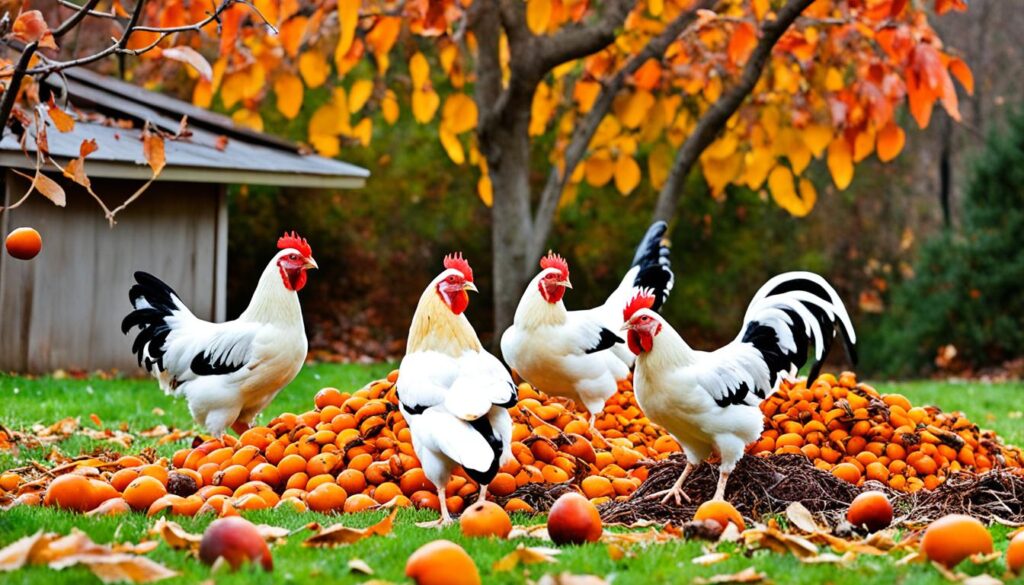
Including a variety of fruits in a chicken’s diet can provide essential vitamins, minerals, and hydration. However, it’s crucial to offer fruits as occasional treats rather than a substantial part of their daily nutrition. By maintaining a balanced and varied diet, chickens can enjoy persimmon skins and other safe fruits as part of a healthy lifestyle.
What Fruits Should I Give to My Chickens?
Chickens can enjoy a variety of fruits as occasional treats. Incorporating safe fruits into their diet provides essential vitamins, minerals, and hydration. However, it’s important to remember that fruits should only make up a small portion of their overall diet, with the main focus on a balanced commercial chicken feed.
Here are some safe fruits that you can give to your chickens:
- Apples
- Bananas
- Berries
- Cantaloupe
- Grapes
- Kiwi
- Mango
- Peaches
- Pumpkins
- Watermelon
These fruits not only provide a tasty treat but also offer a range of nutritional benefits. For example, bananas are a great source of potassium, while berries are packed with antioxidants. Watermelon and cantaloupe help keep chickens hydrated, especially during hot summer months.
It’s important to introduce these fruits in moderation to prevent overindulgence and ensure a balanced diet. Too much fruit can be disruptive to their digestive system or lead to obesity. Monitor their intake and observe any changes in behavior or health to ensure their well-being.
Benefits of Safe Fruits for Chickens
| Fruit | Nutritional Benefits |
|---|---|
| Apples | High in fiber and contain vitamins A, C, and E |
| Bananas | Rich in potassium and vitamin B6 |
| Berries | Packed with antioxidants and vitamin C |
| Cantaloupe | Hydrating and a good source of vitamins A and C |
| Grapes | Contain antioxidants and vitamins C and K |
| Kiwi | Rich in vitamin C, fiber, and folate |
| Mango | High in vitamins A and C |
| Peaches | Provide vitamins A and C |
| Pumpkins | Rich in beta-carotene and a good source of fiber |
| Watermelon | Hydrating and contains vitamins A and C |
Remember to always wash fruits thoroughly, remove any pits or seeds, and serve them in appropriate sizes for chickens. By offering a variety of safe fruits as occasional treats, you can keep your chickens happy, healthy, and entertained.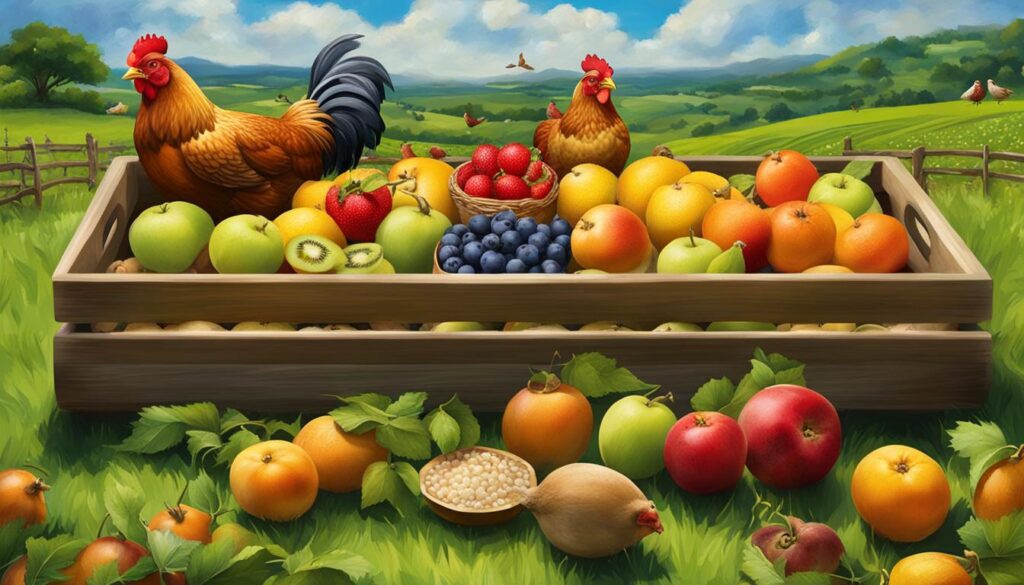
Conclusion
In conclusion, persimmons can be safely incorporated into a chicken’s diet as part of a balanced feeding routine. These delicious fruits offer a range of nutritional benefits, including essential vitamins and minerals that contribute to the overall well-being of chickens.
However, it’s important to feed persimmons to chickens in moderation. While persimmons are a natural source of sweetness, their high sugar content can cause issues if consumed excessively. Therefore, it’s crucial to monitor the quantity of persimmons and ensure they are not overindulging.
Additionally, it’s essential to consider potential drawbacks when feeding persimmons to chickens. Chickens with specific health conditions, such as diabetes or obesity, should have their persimmon intake limited. Moreover, care should be taken to prevent intestinal blockages that may occur if chickens consume an excessive amount of persimmon seeds.
To safely introduce persimmons into a chicken’s diet, it’s recommended to start gradually and observe their response. By offering a varied selection of treats alongside persimmons, chickens can enjoy a diverse diet while receiving the necessary nutrients. Prioritizing their regular feed is also vital to maintain a balanced nutritional intake.
FAQ
Can chickens eat persimmons?
Do persimmons provide any nutritional benefits to chickens?
How should I introduce persimmons to my chickens?
Are there any potential risks or drawbacks to feeding persimmons to chickens?
Can chickens eat persimmon leaves?
Are there any foods that I should avoid giving to chickens?
Can chickens eat persimmon skin?
What other fruits can I give to my chickens?
Is it safe to feed persimmons to chickens?
Paul’s love for animals knows no bounds. As a dedicated writer and animal lover, Paul brings a unique perspective to our team. His firsthand experiences with various animals enrich our content and provide valuable insights into their behavior and needs. Whether he’s sharing tips for pet care or shedding light on pressing conservation issues, Paul’s passion for animals shines through in everything he does.
-

 Vetted1 month ago
Vetted1 month ago15 Best Dog Food Brands Recommended by Vets for Healthy and Happy Pups
-

 Vetted1 month ago
Vetted1 month ago14 Best Homemade Dog Food Recipes Your Pup Will Love – Vet Approved & Nutritious
-

 Vetted1 month ago
Vetted1 month ago15 Best Cat Foods for Managing Hyperthyroidism – Vet Approved and Feline Friendly
-
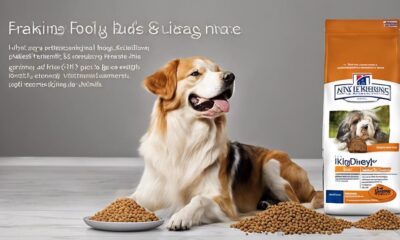
 Vetted3 weeks ago
Vetted3 weeks ago15 Best Dog Foods for Kidney Disease – Expert Recommendations for Your Pet's Health
-

 Vetted2 weeks ago
Vetted2 weeks ago15 Best Affordable Cat Foods That Won't Break the Bank
-
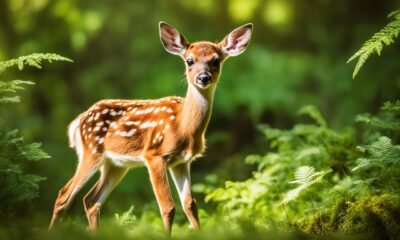
 Deers1 month ago
Deers1 month agoCaring for Baby Deer: Tips for Healthy Fawns
-
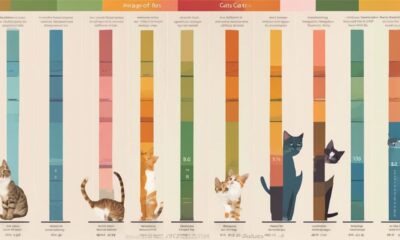
 Cats6 days ago
Cats6 days agoCat Weight Chart by Age: Kitten to Senior in Lbs
-
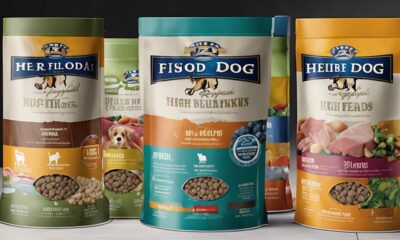
 Vetted1 month ago
Vetted1 month ago15 Best Kibble Dog Foods for a Healthy and Happy Pup





















